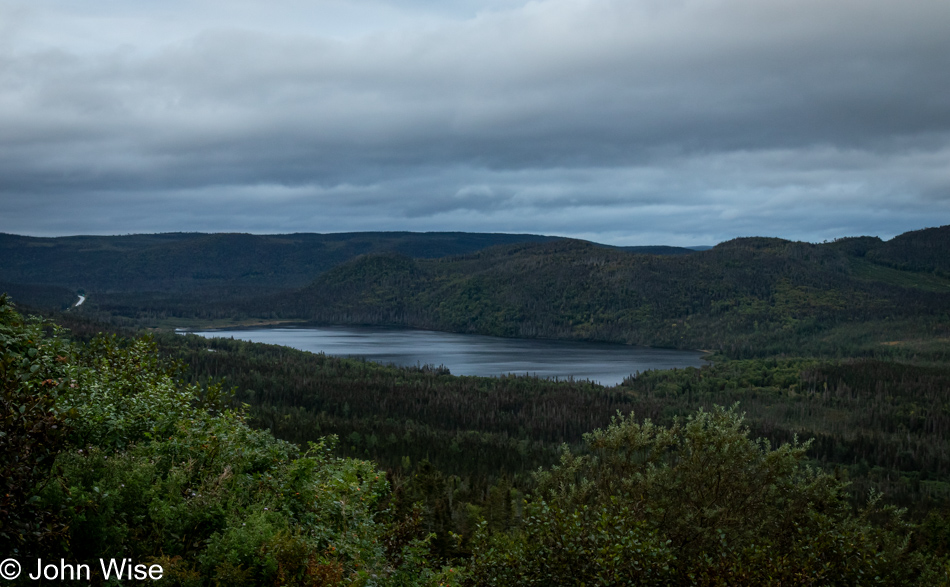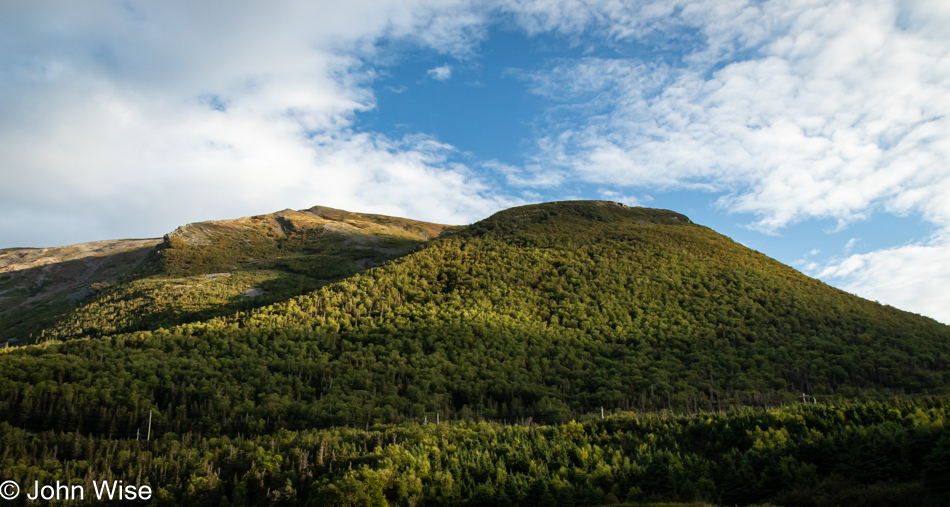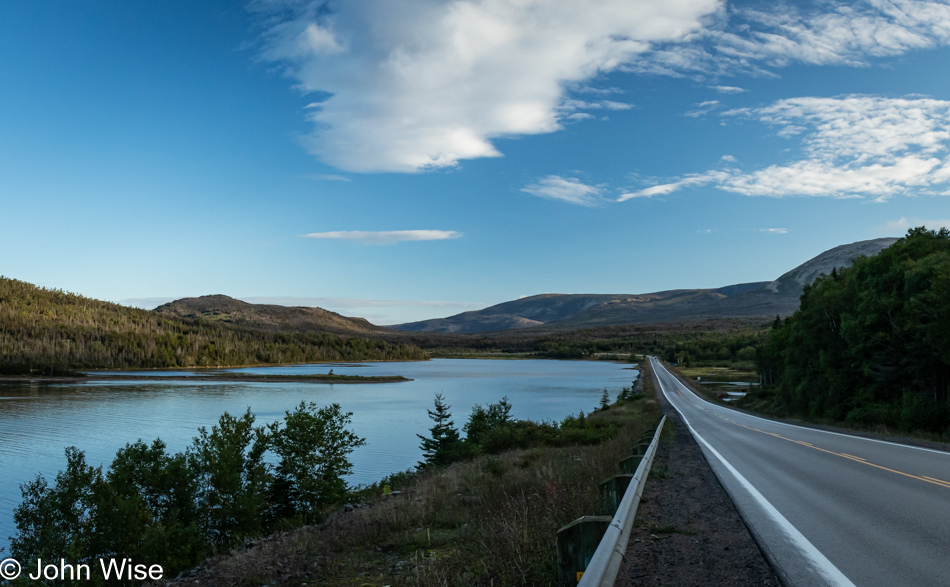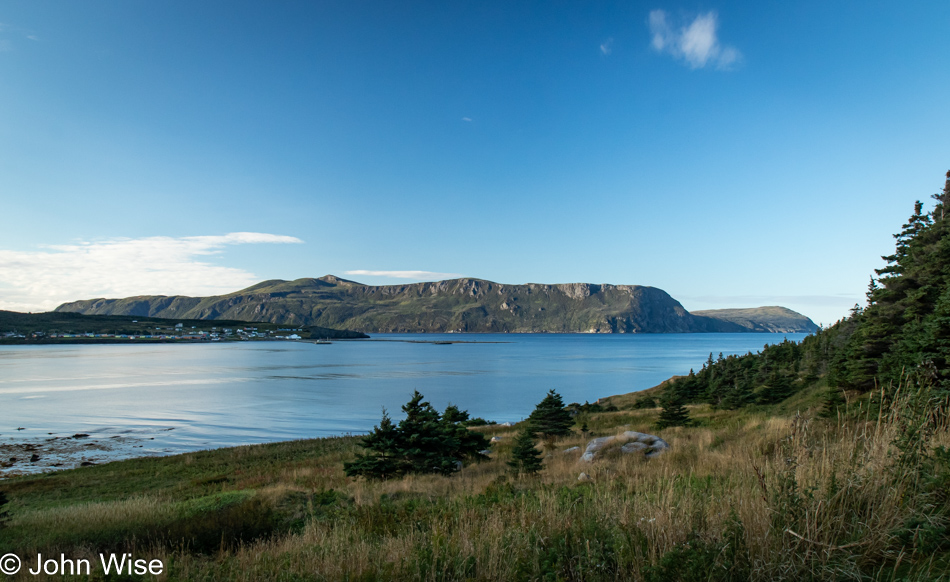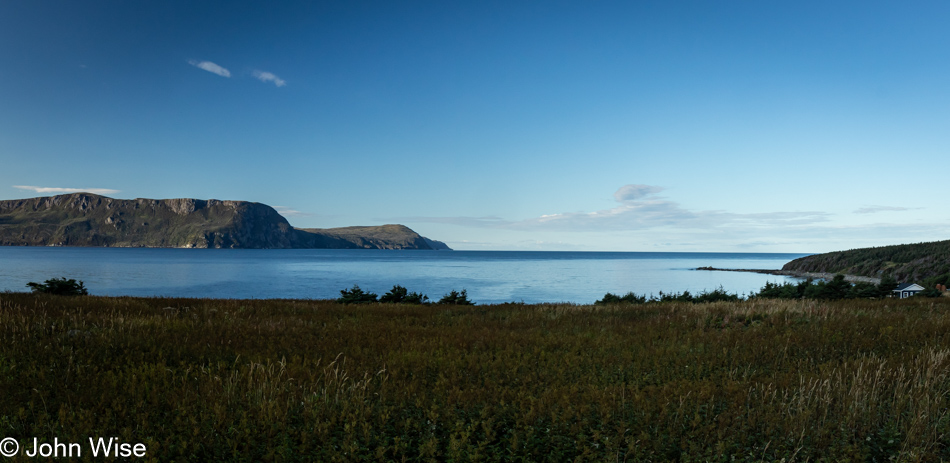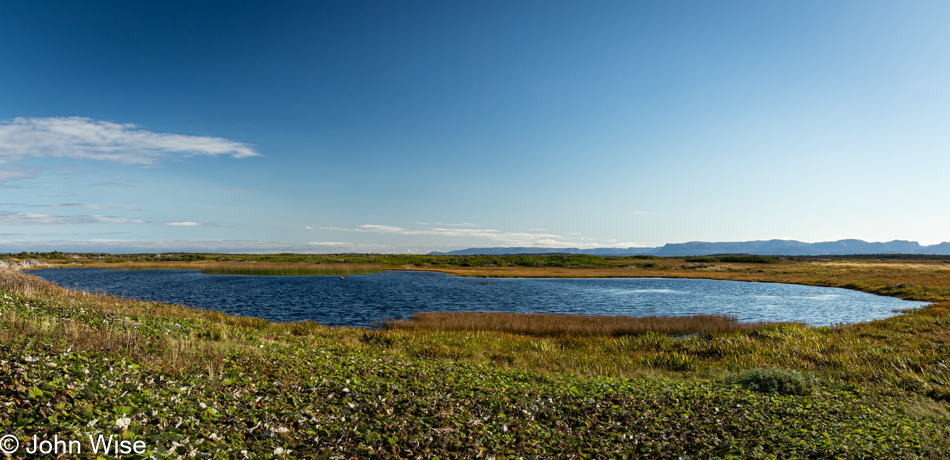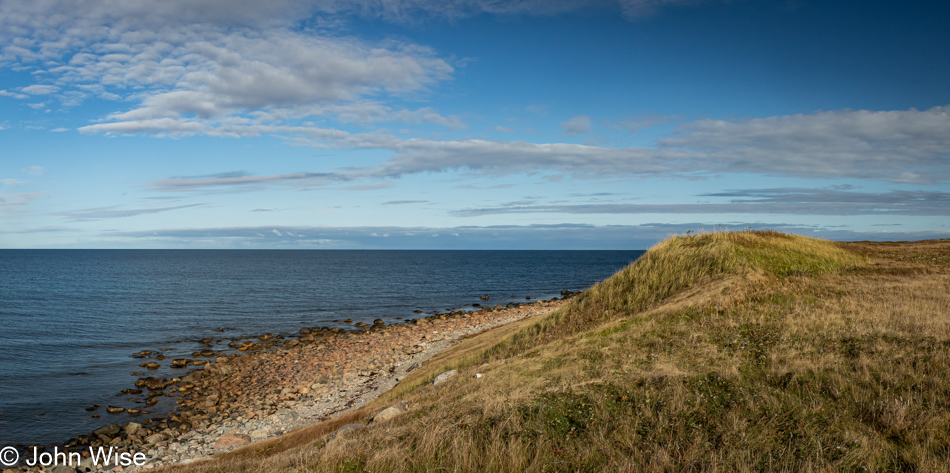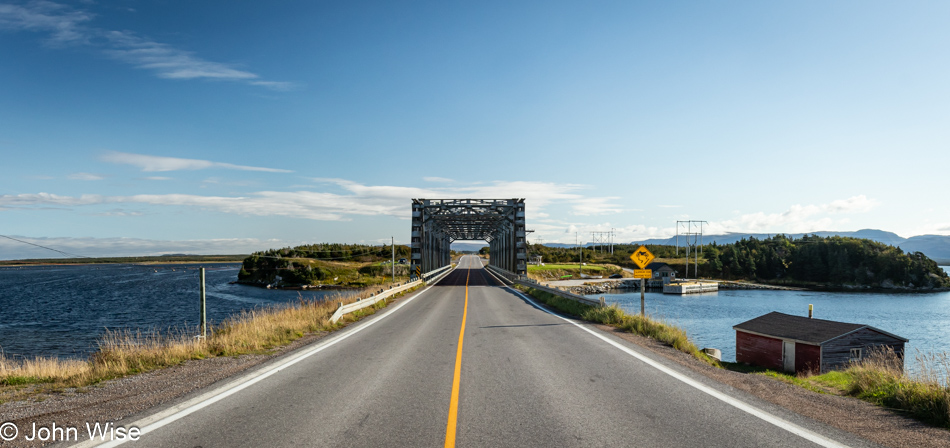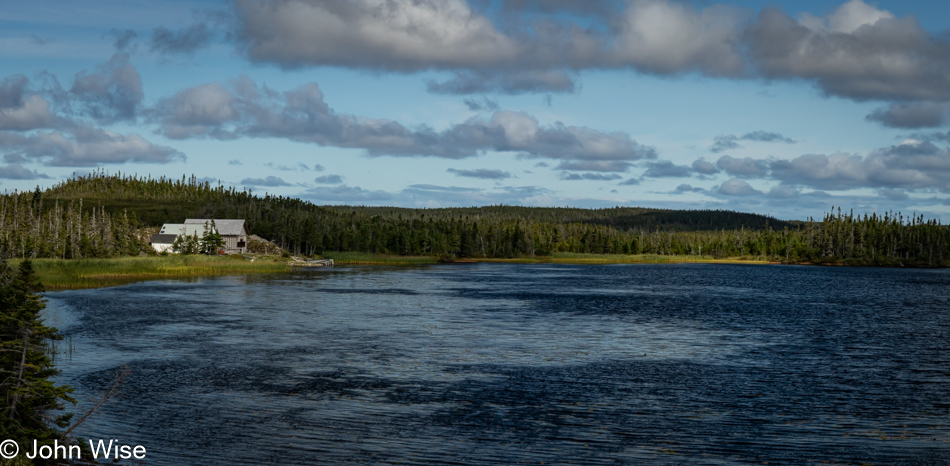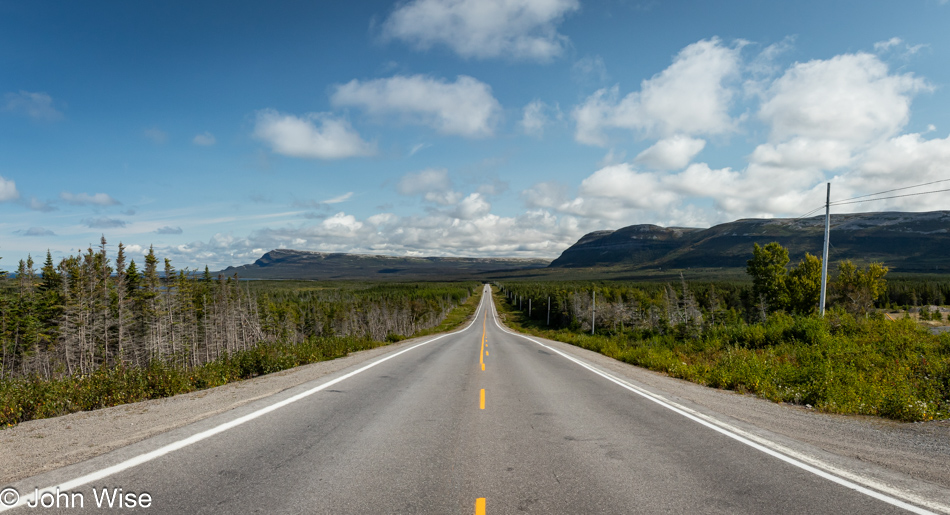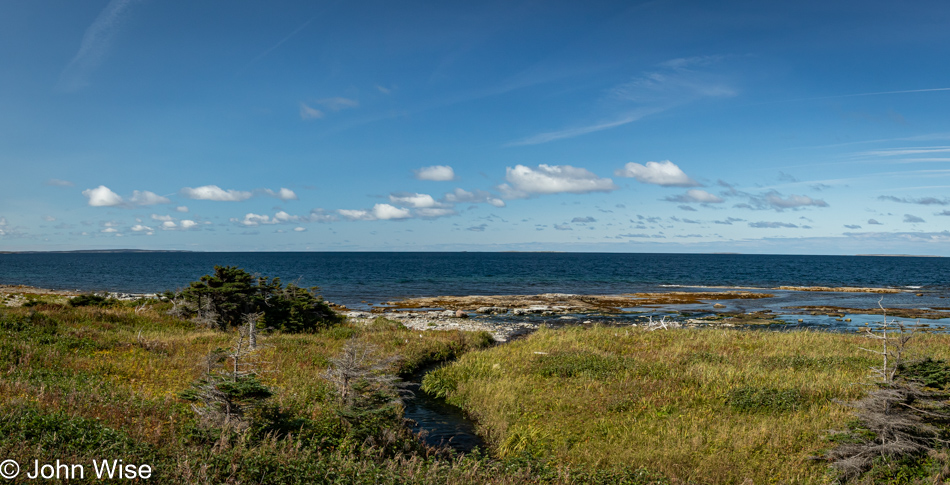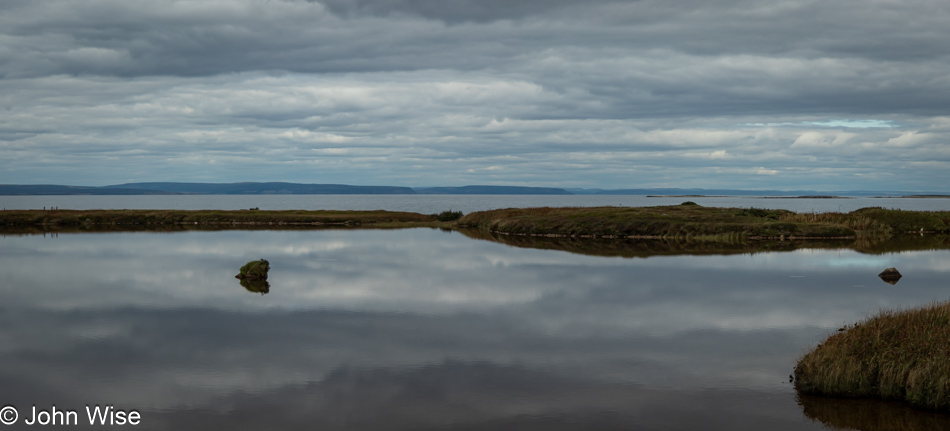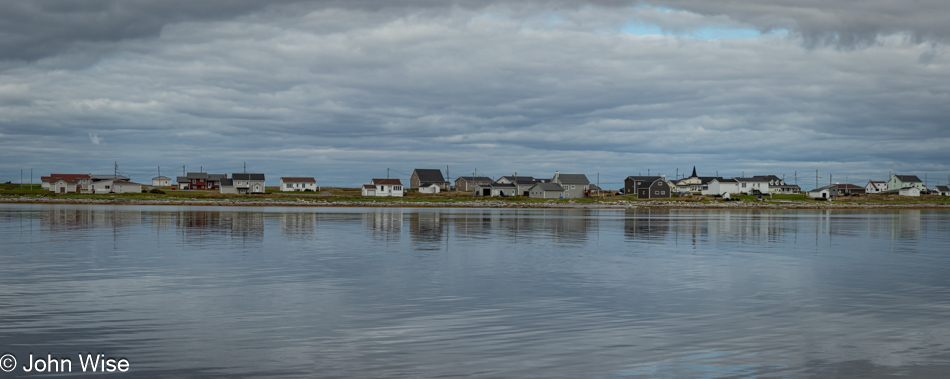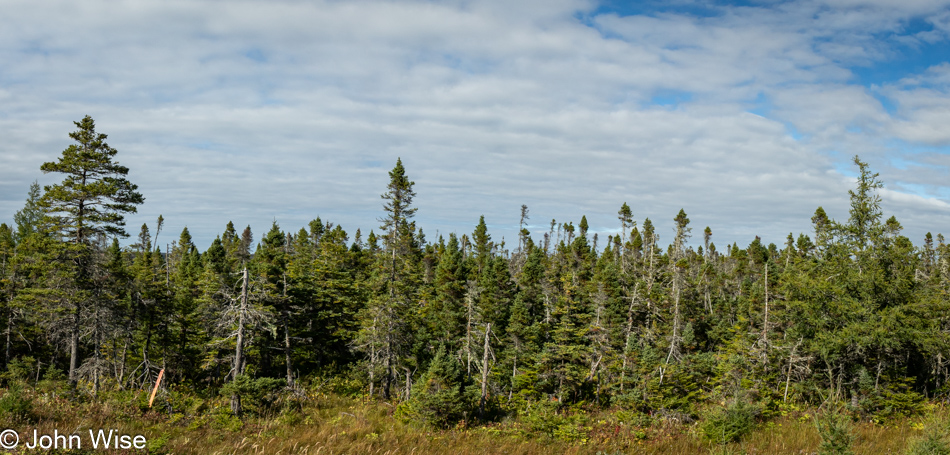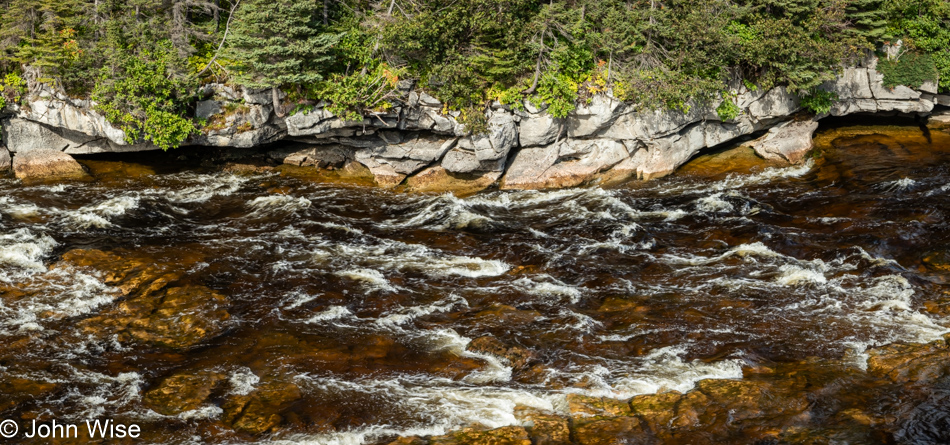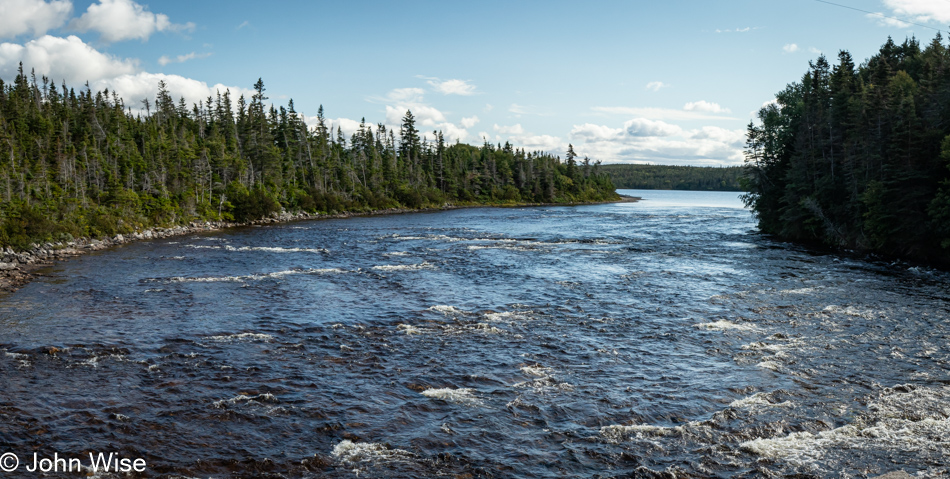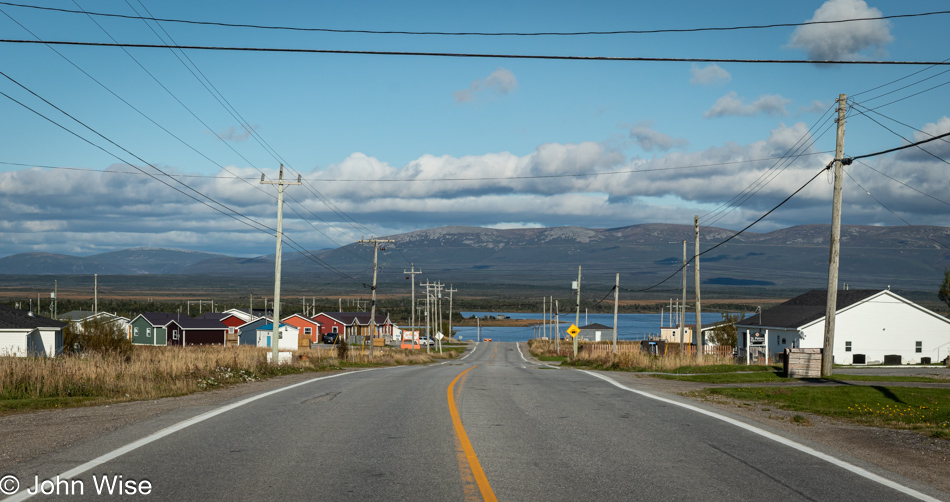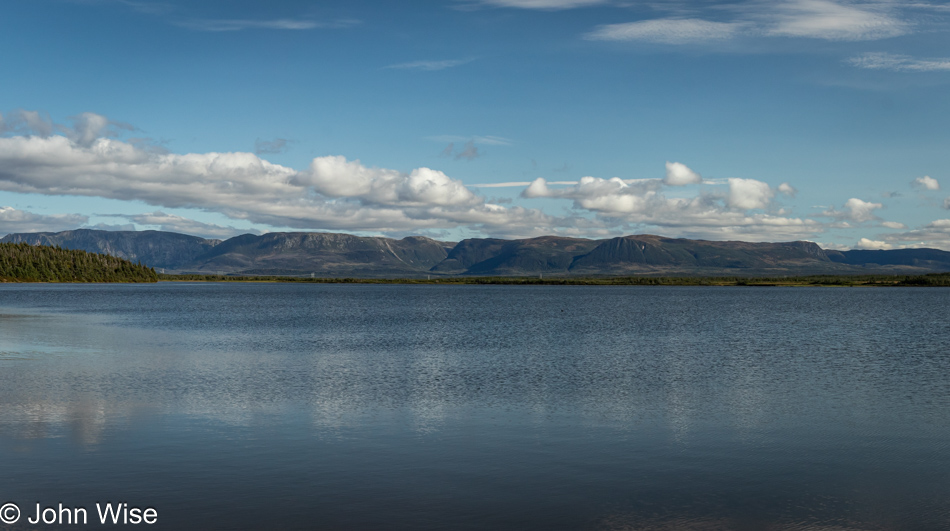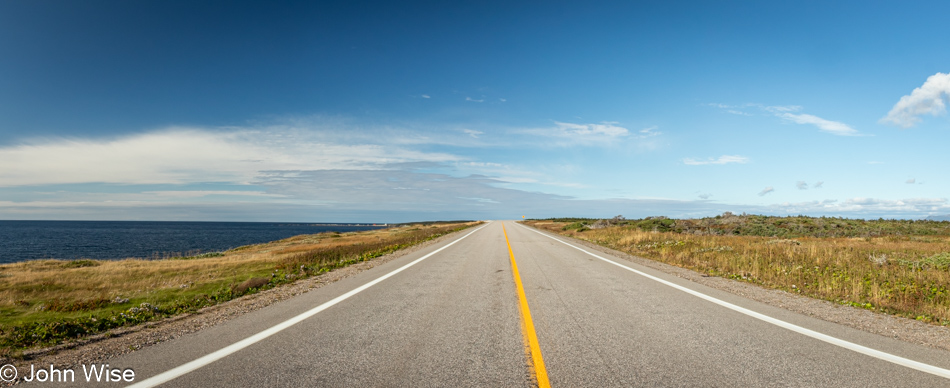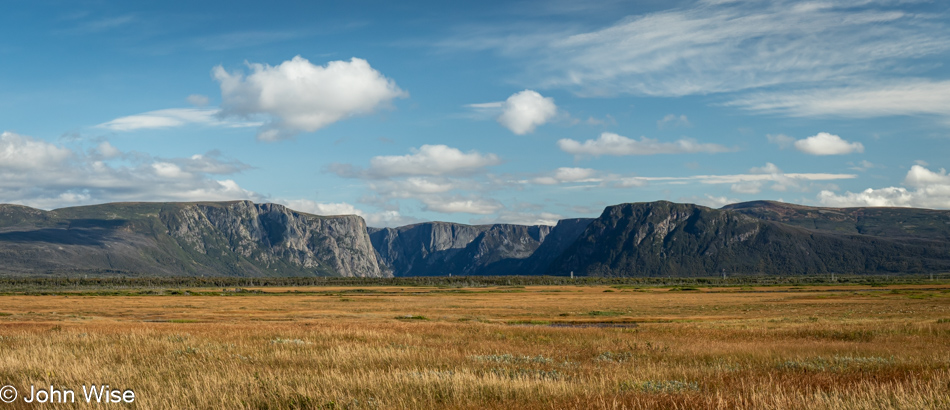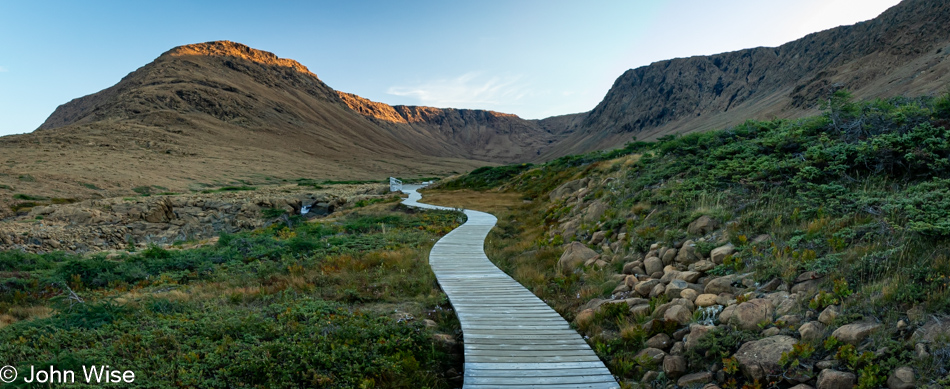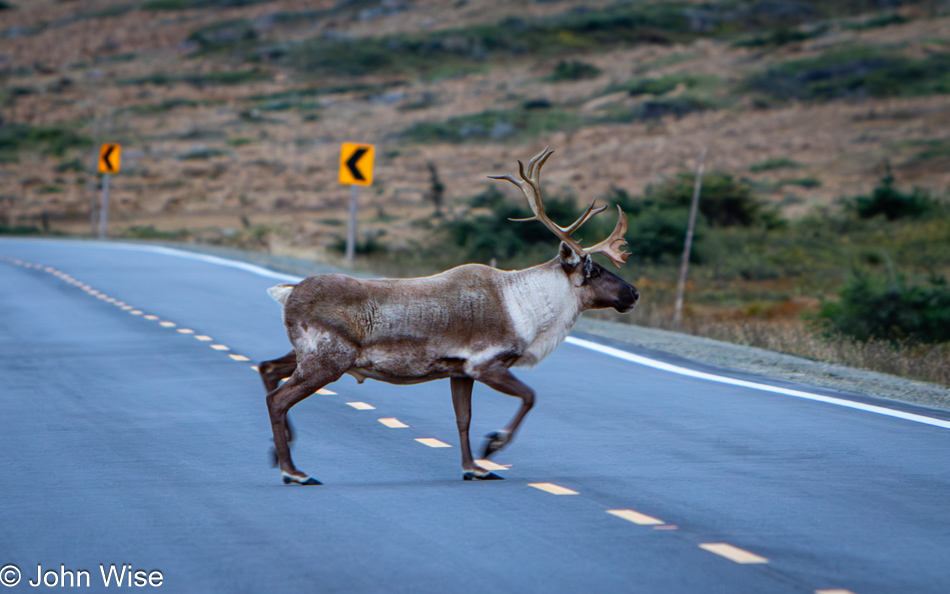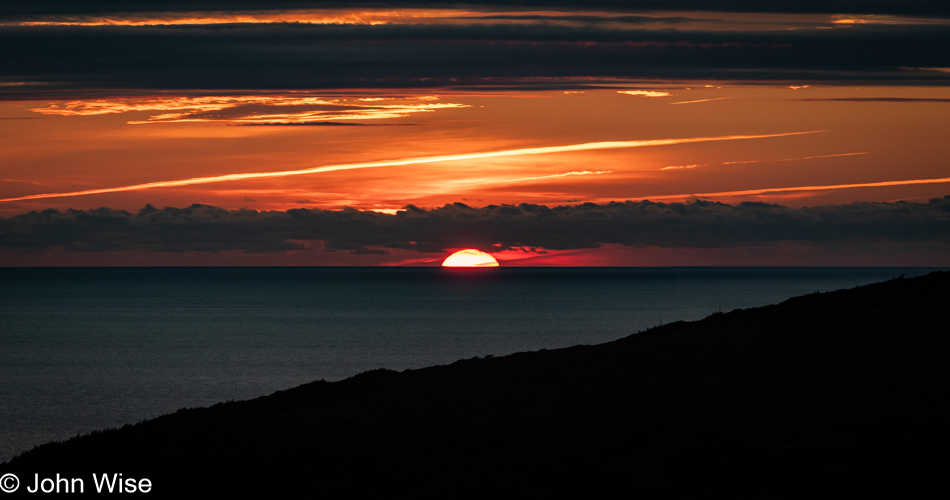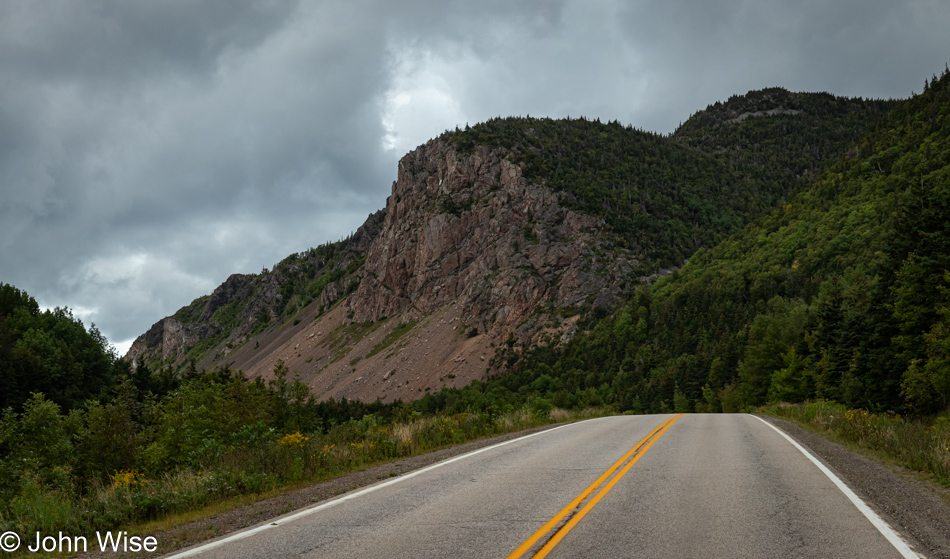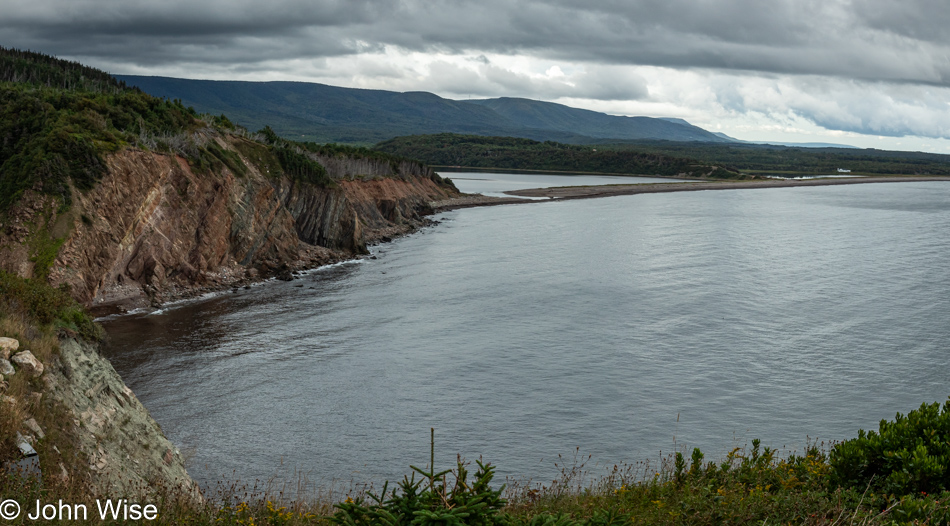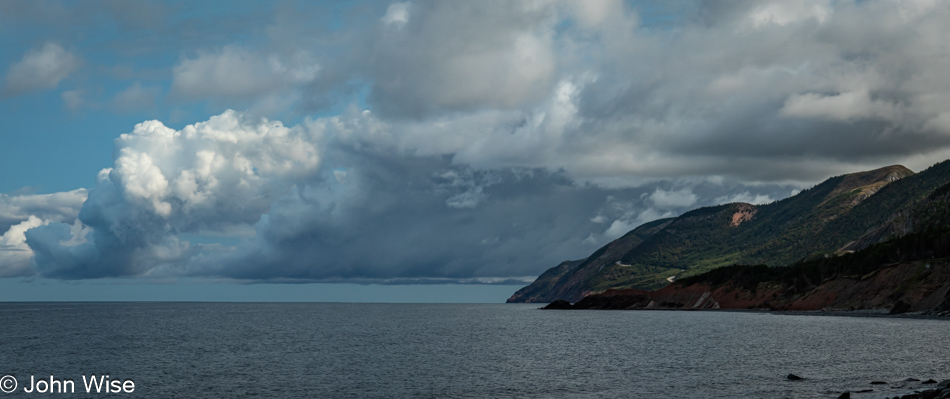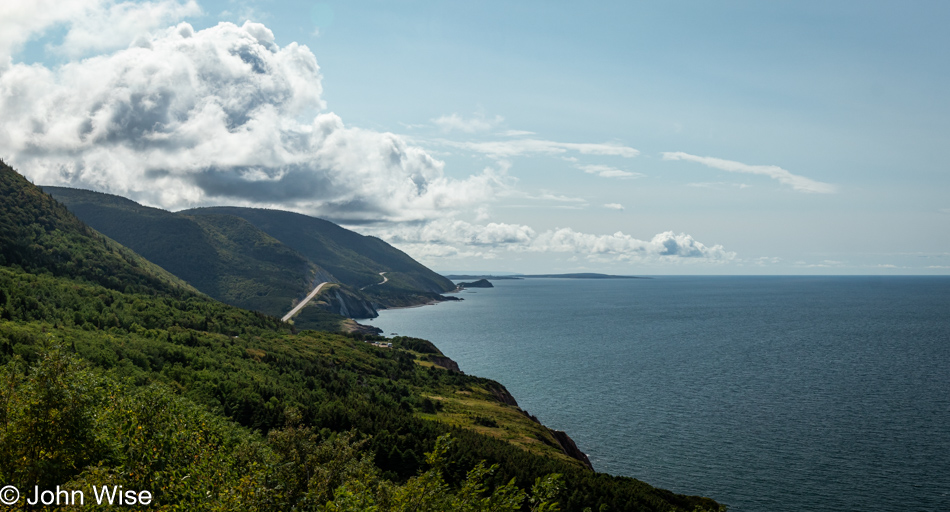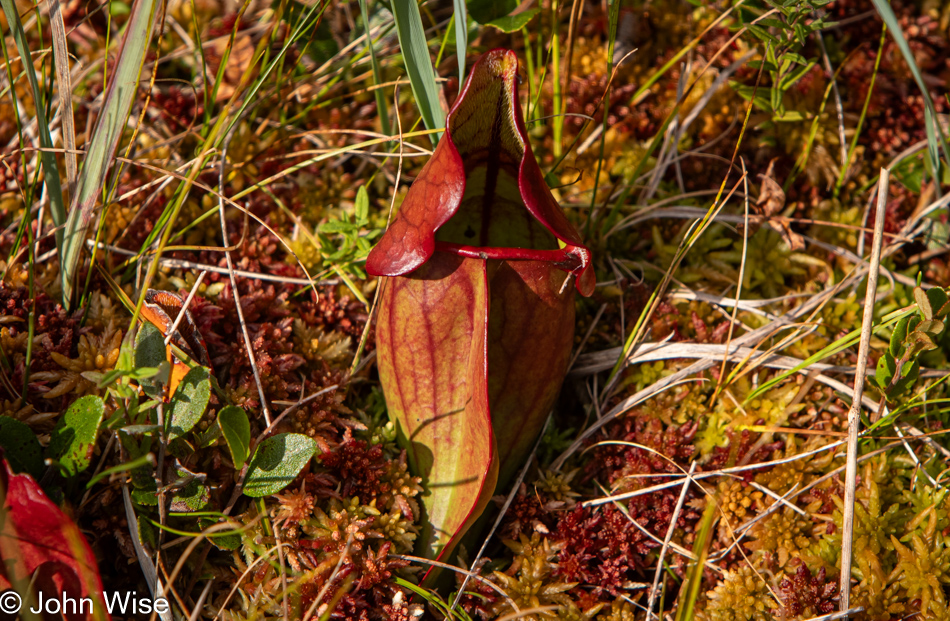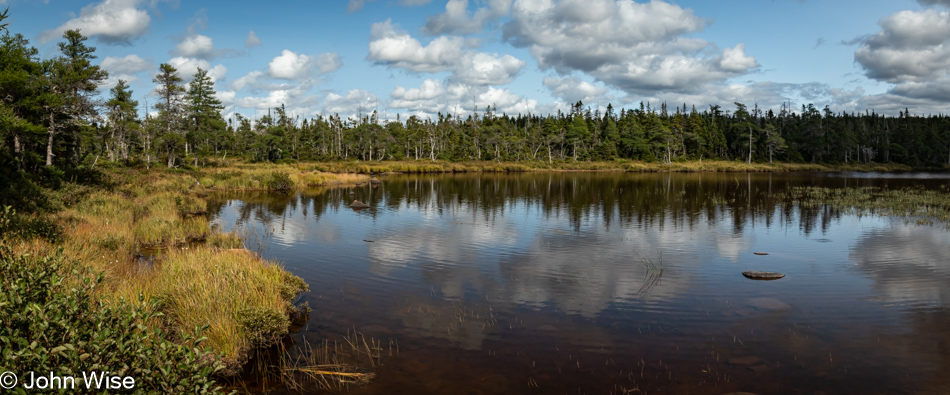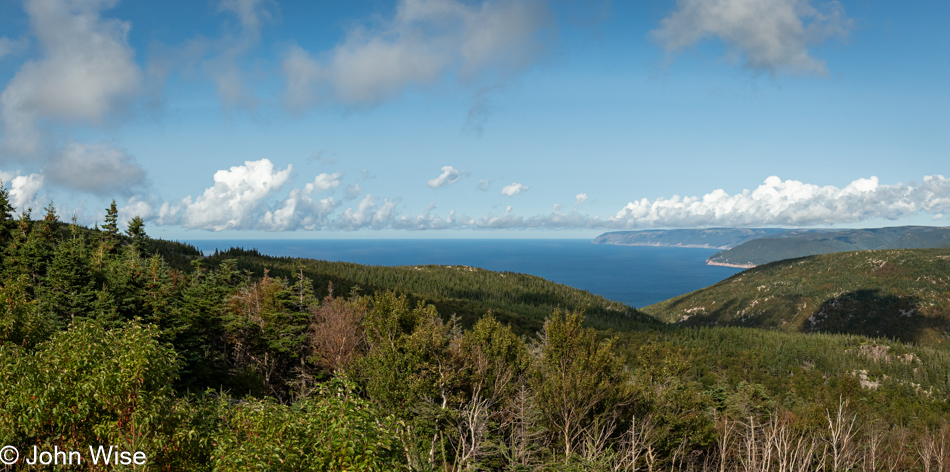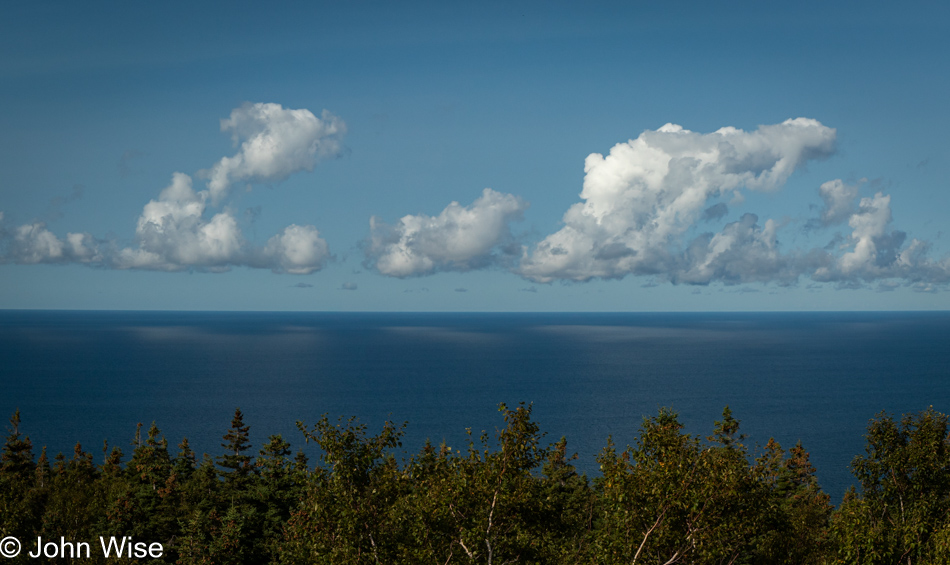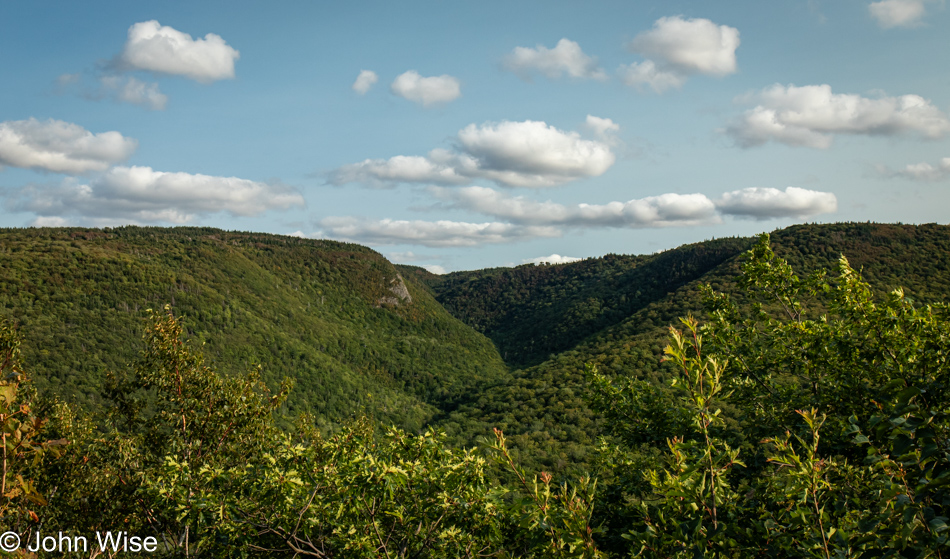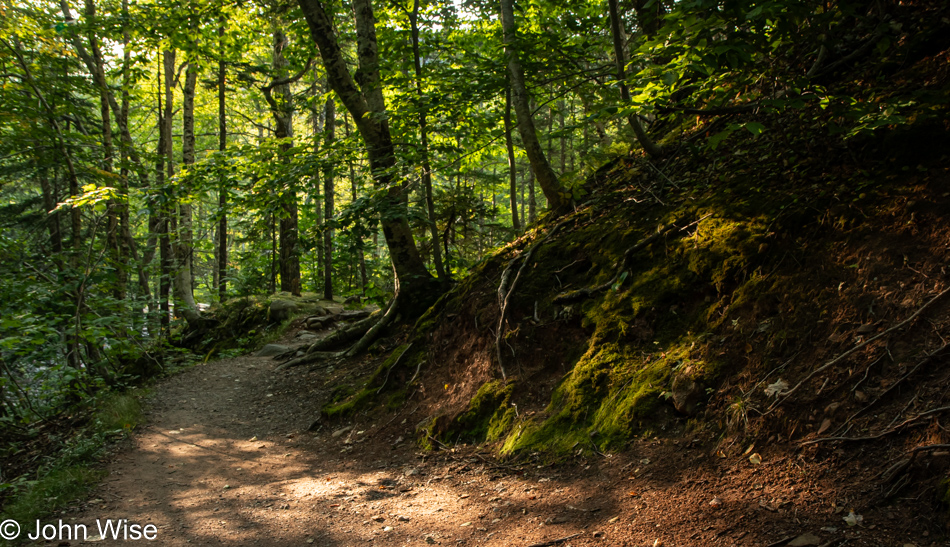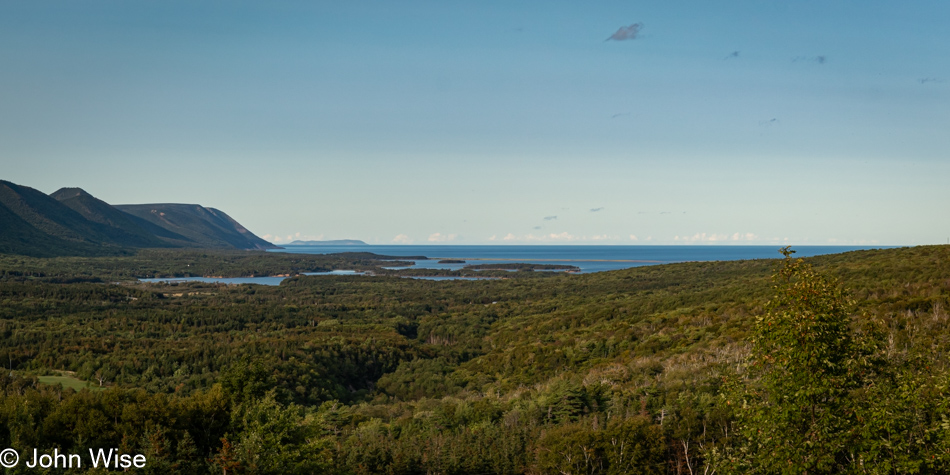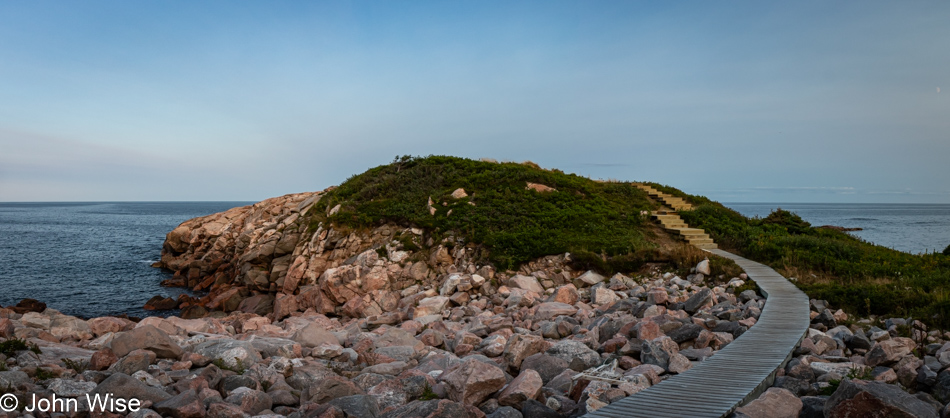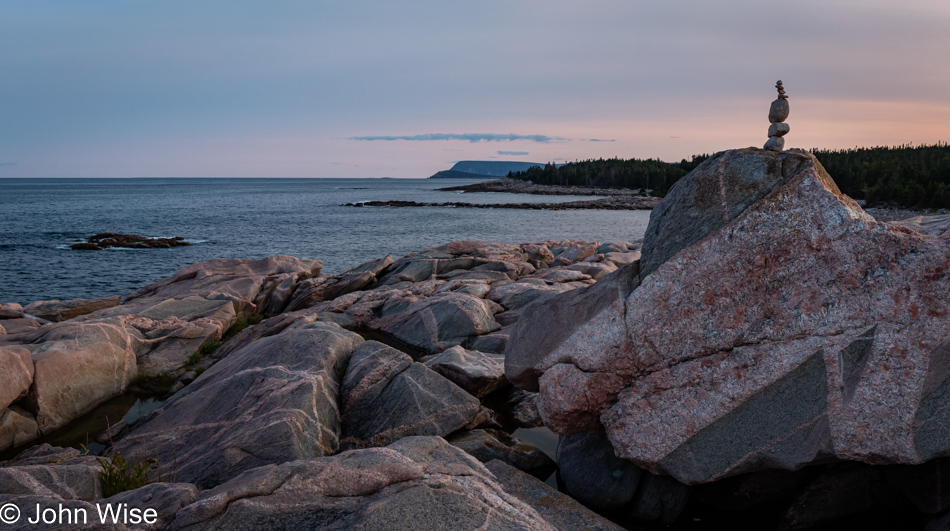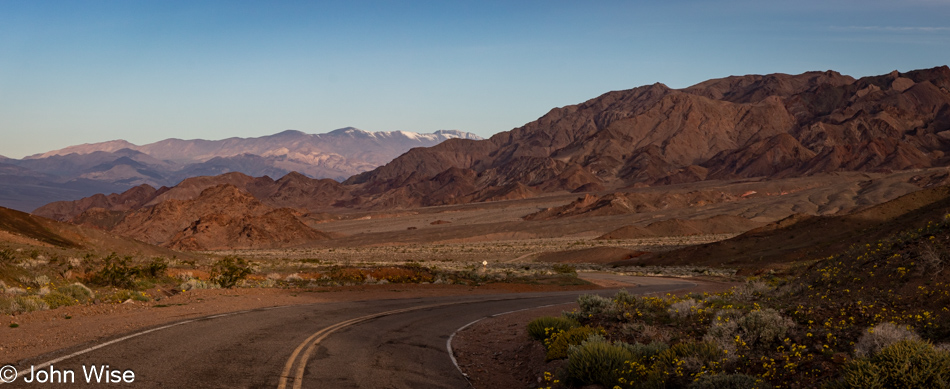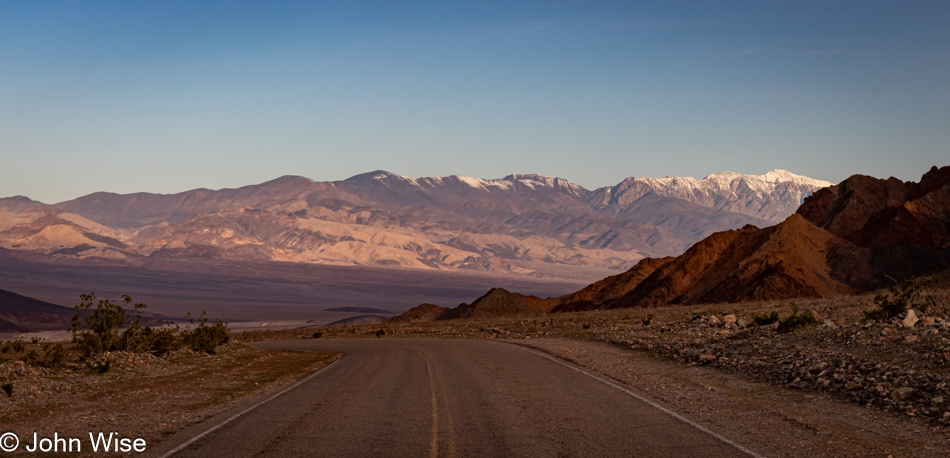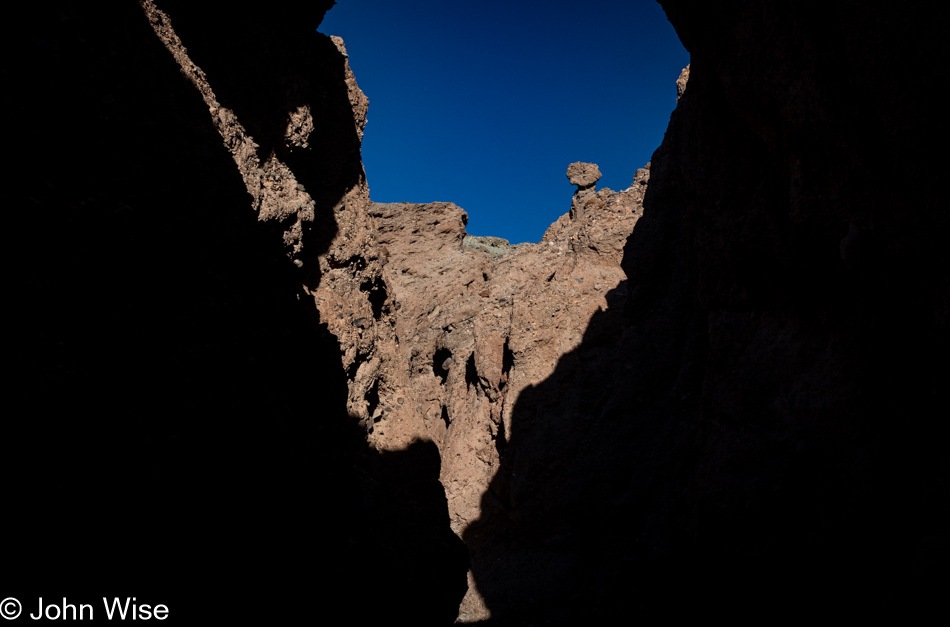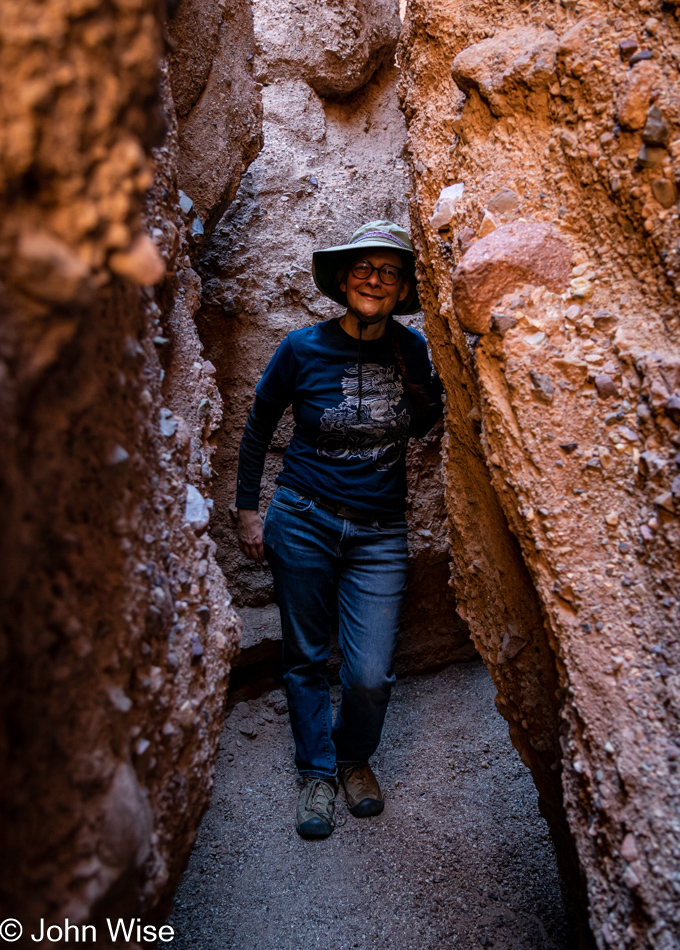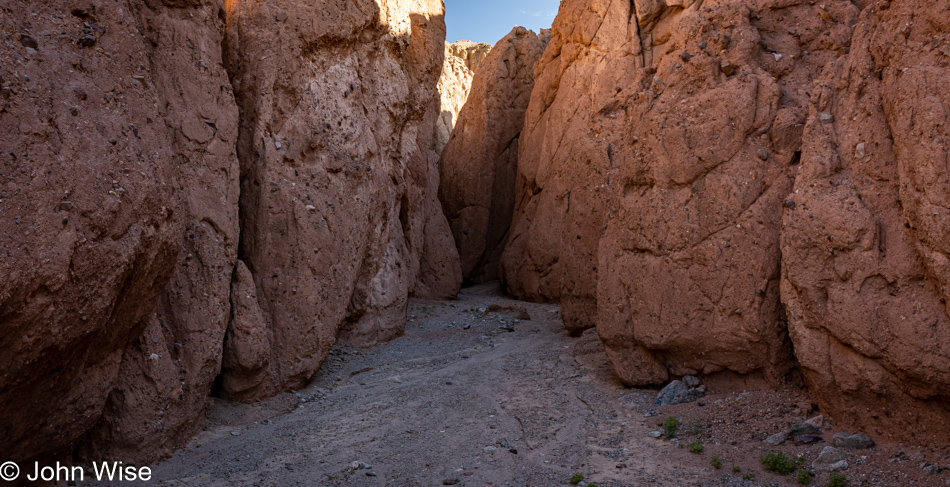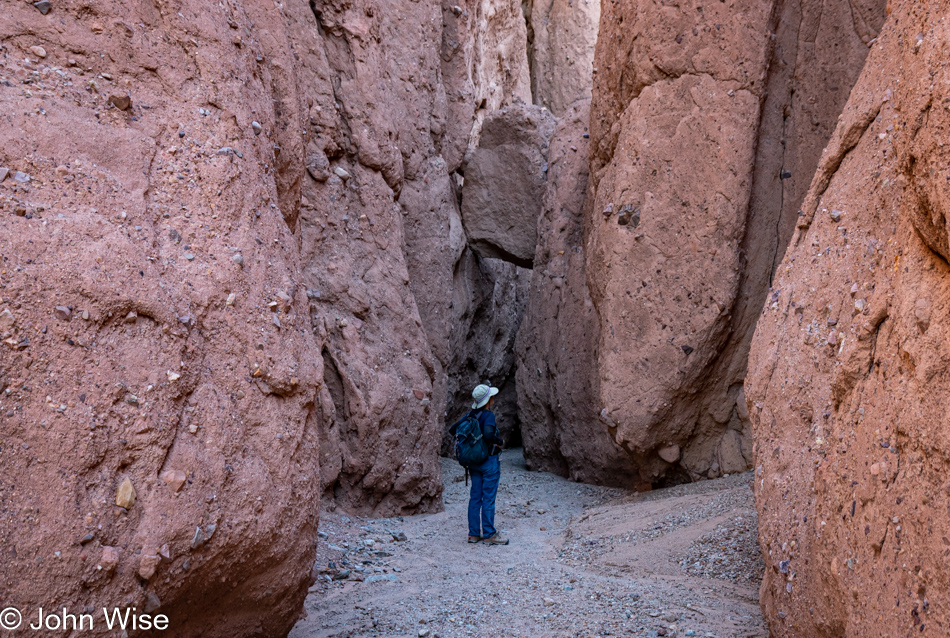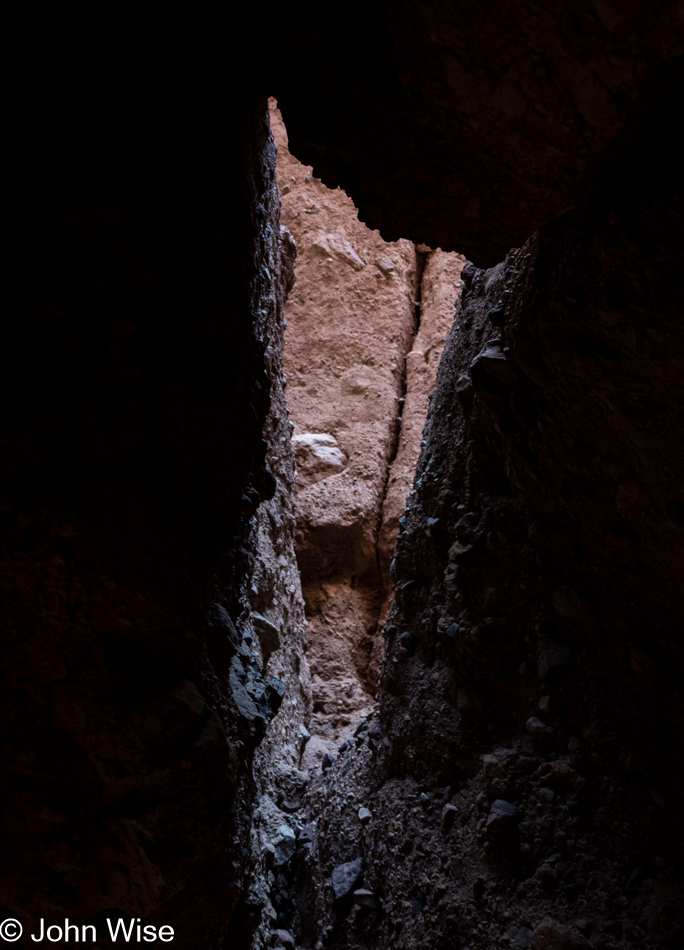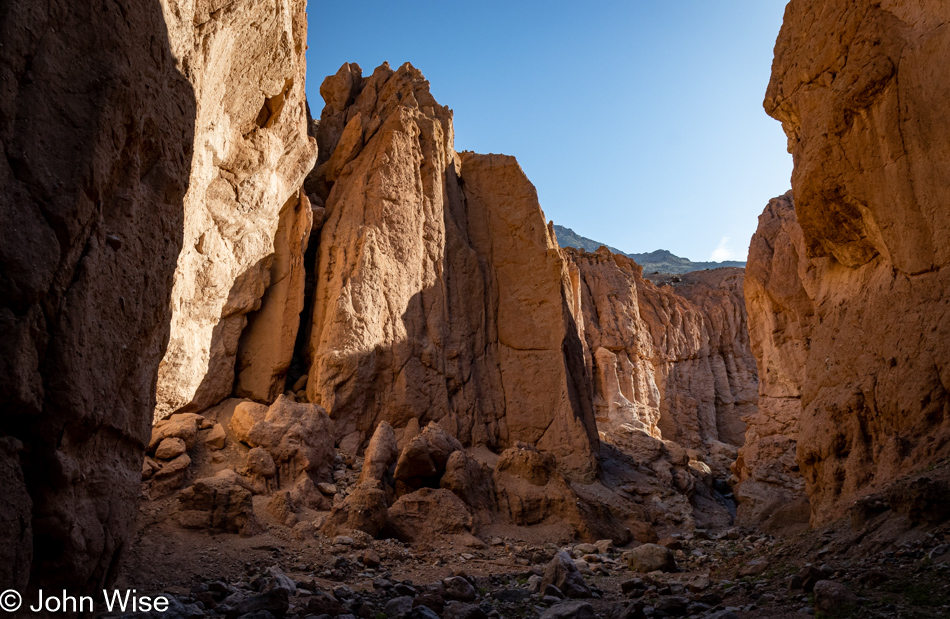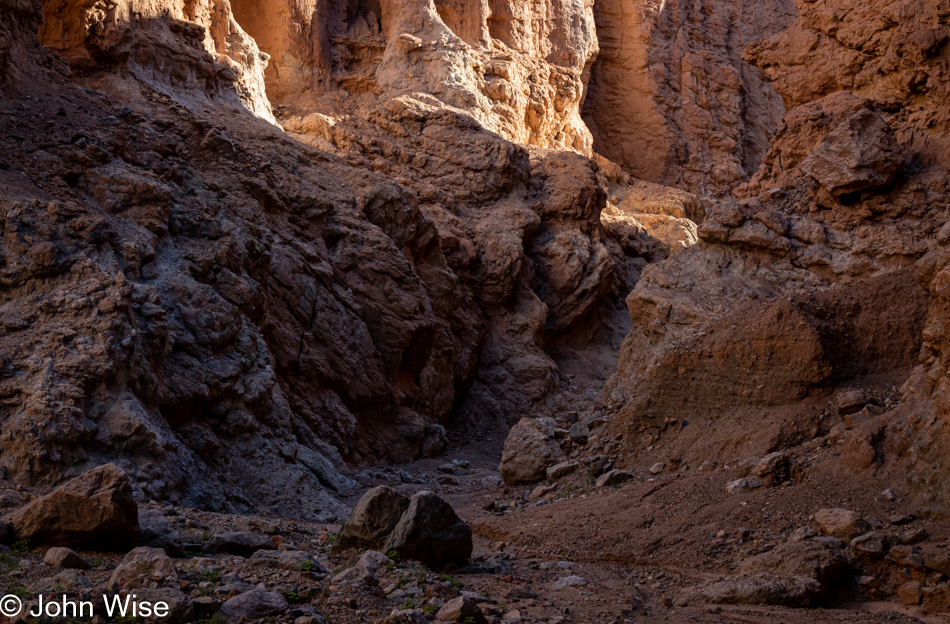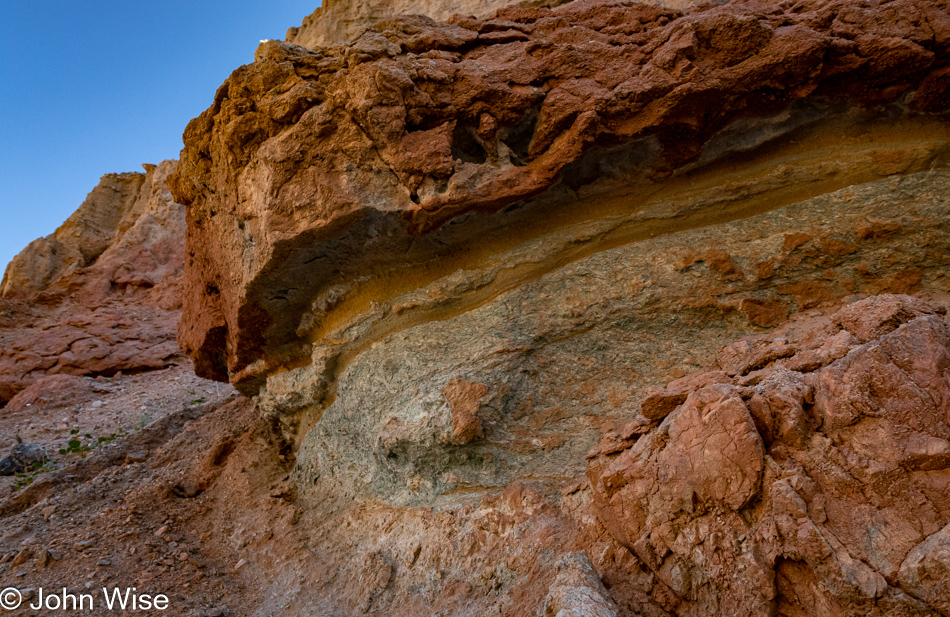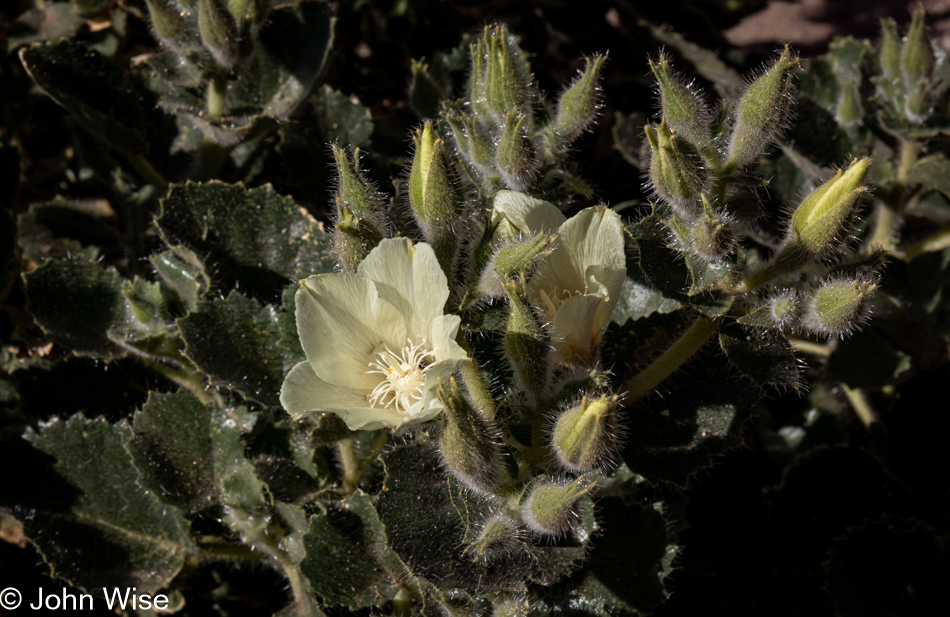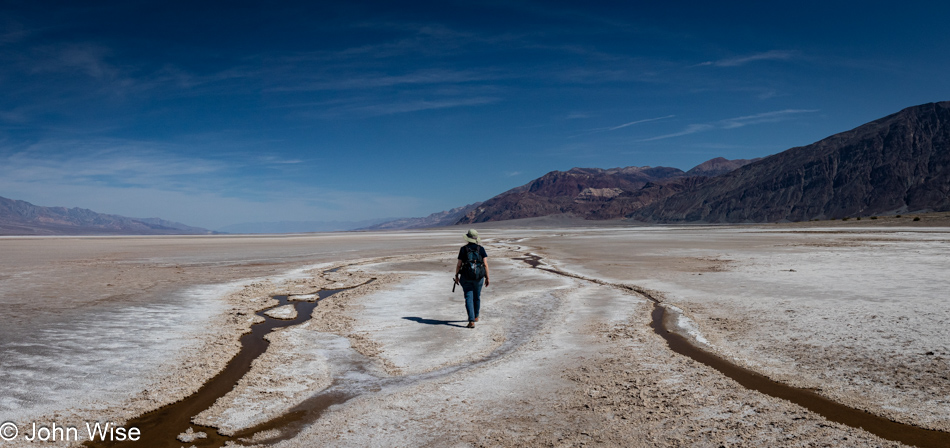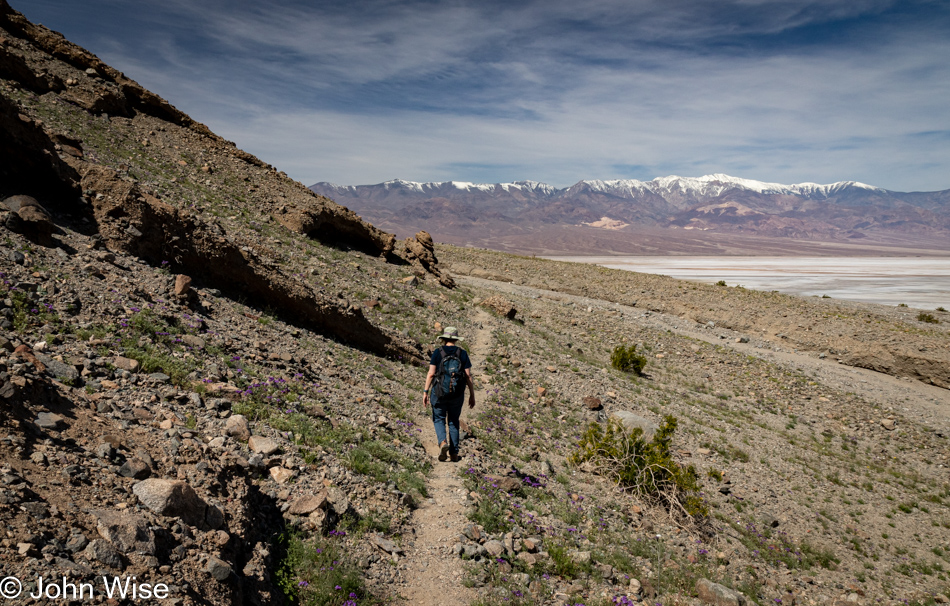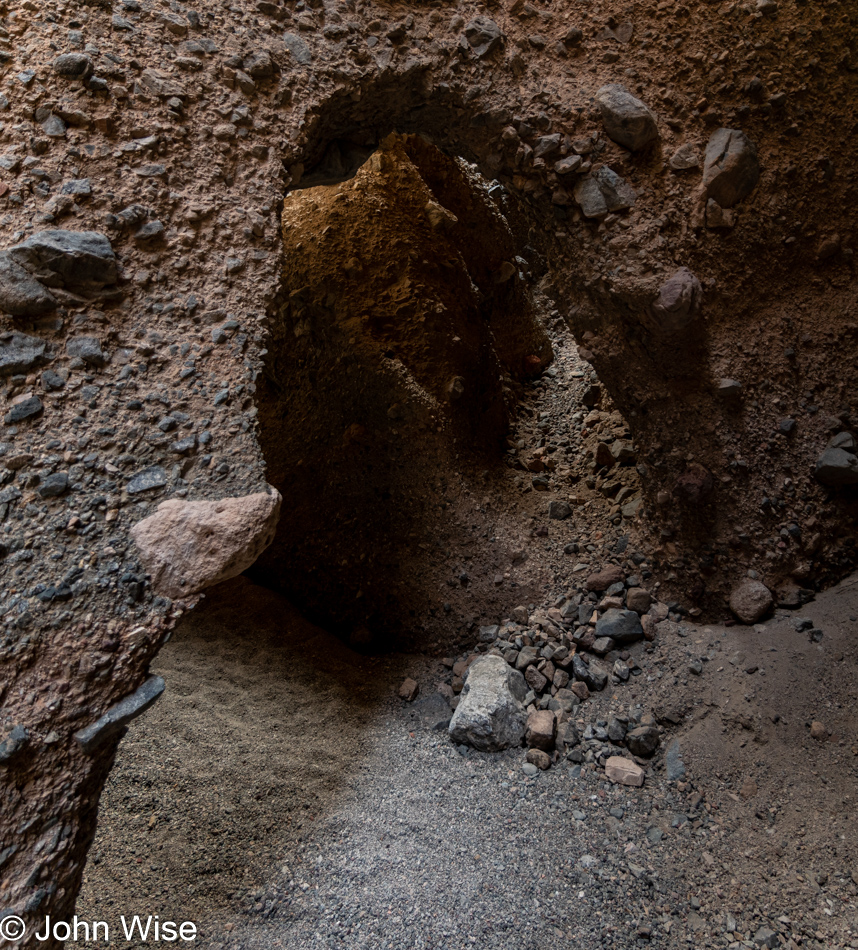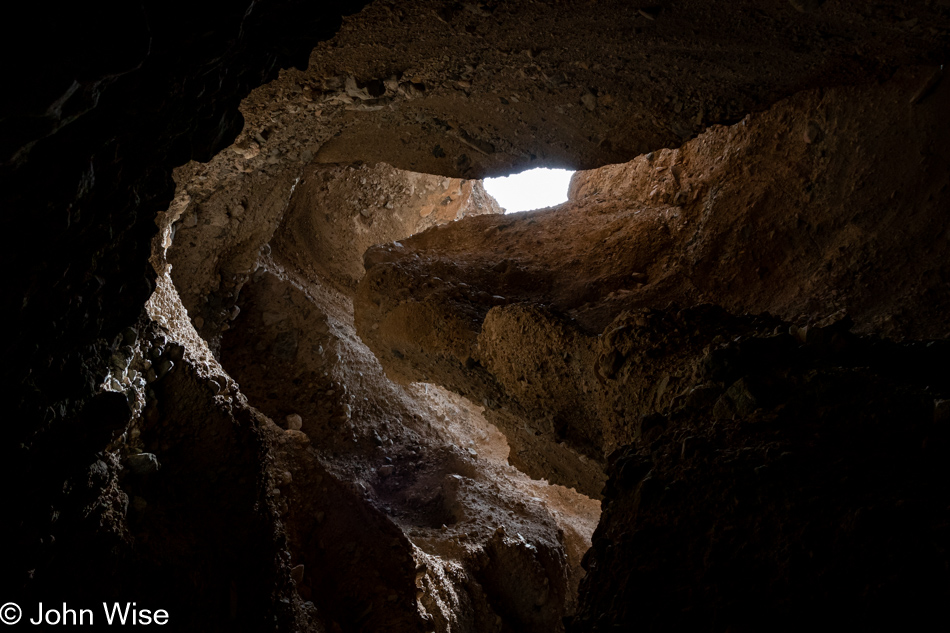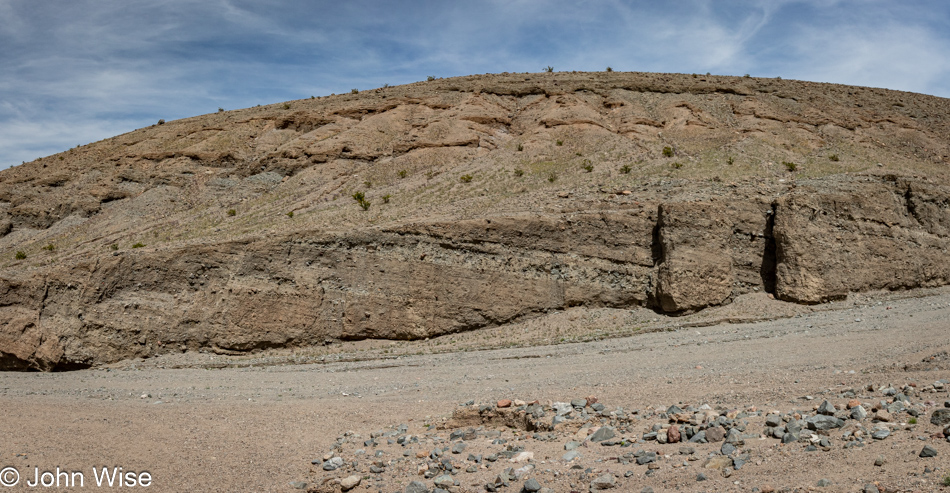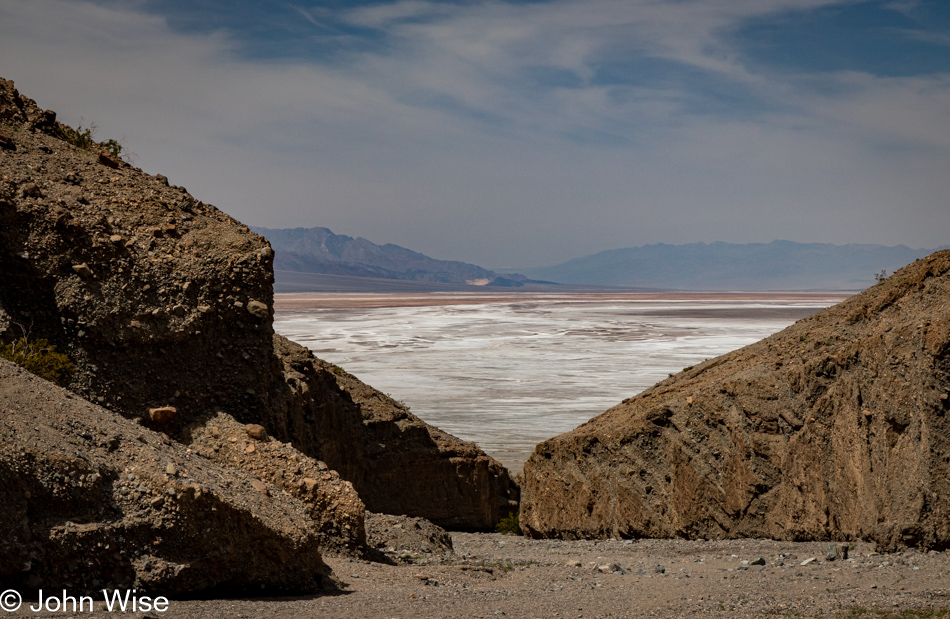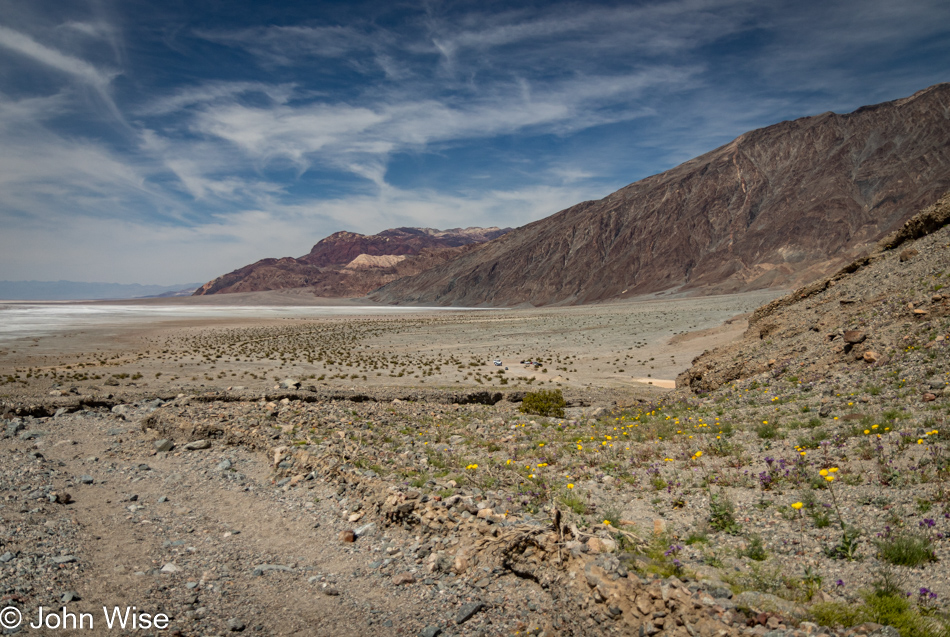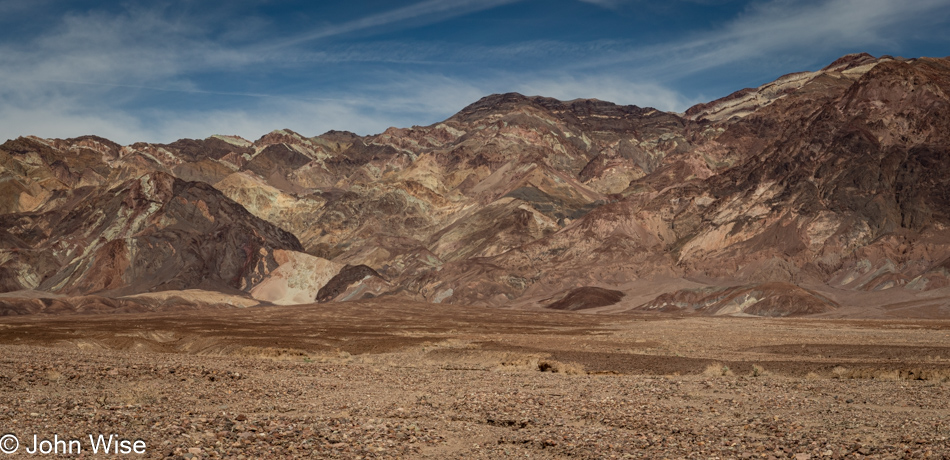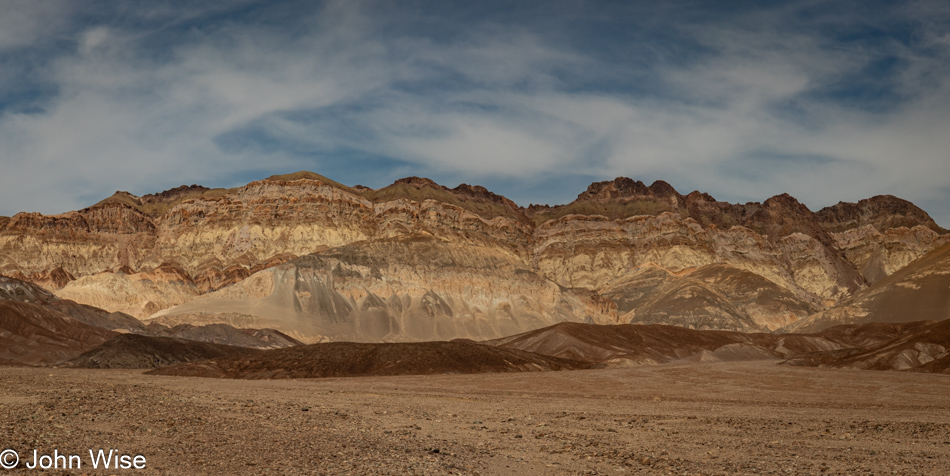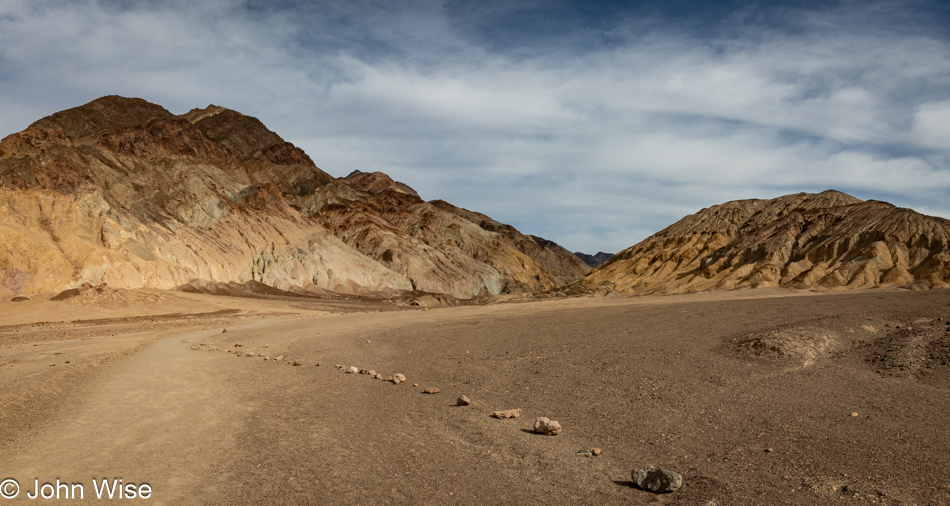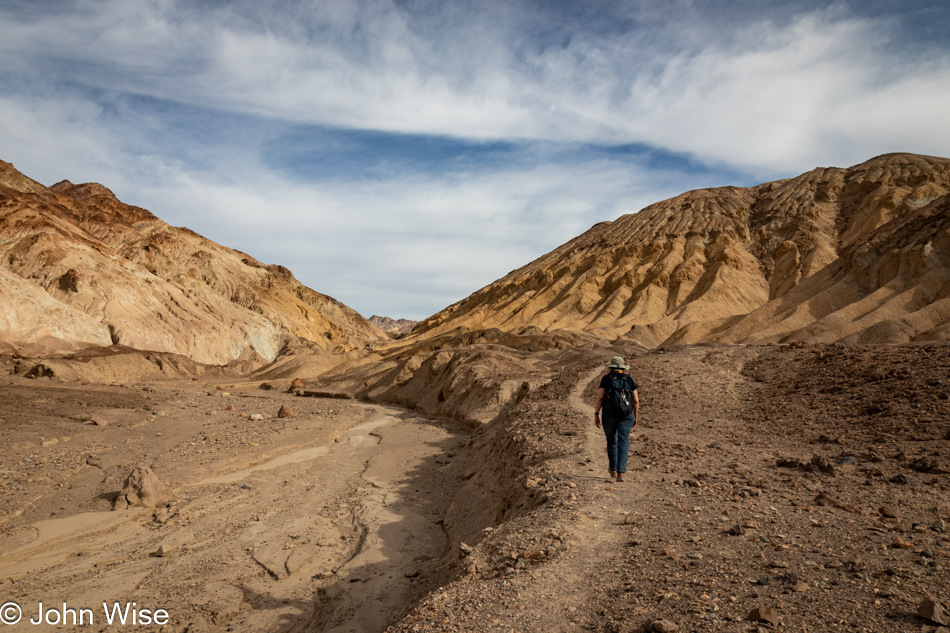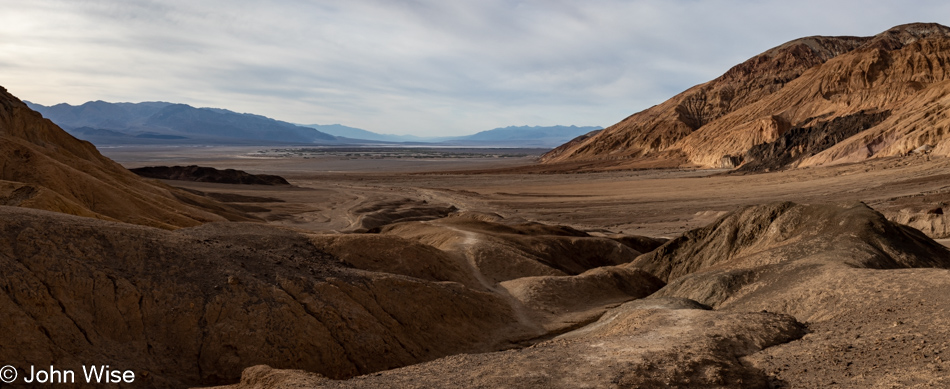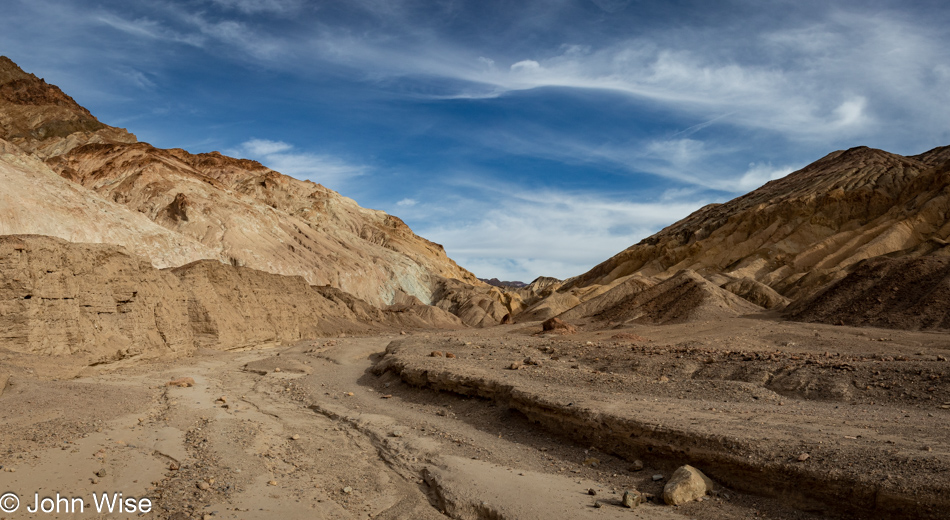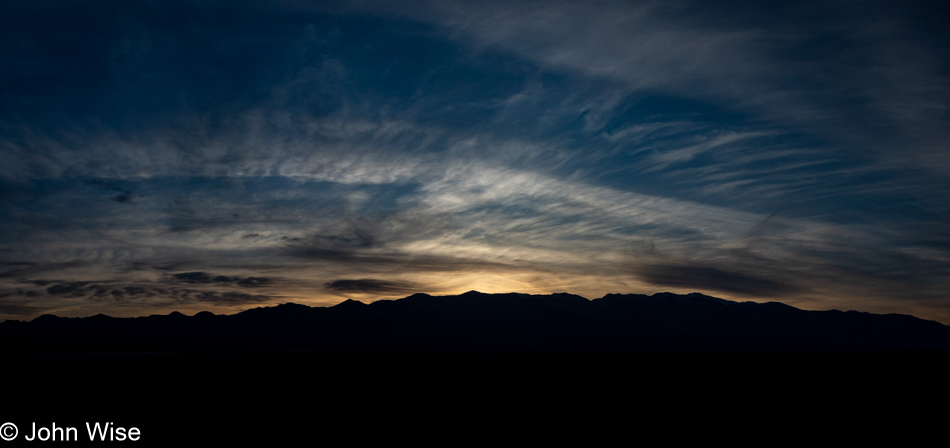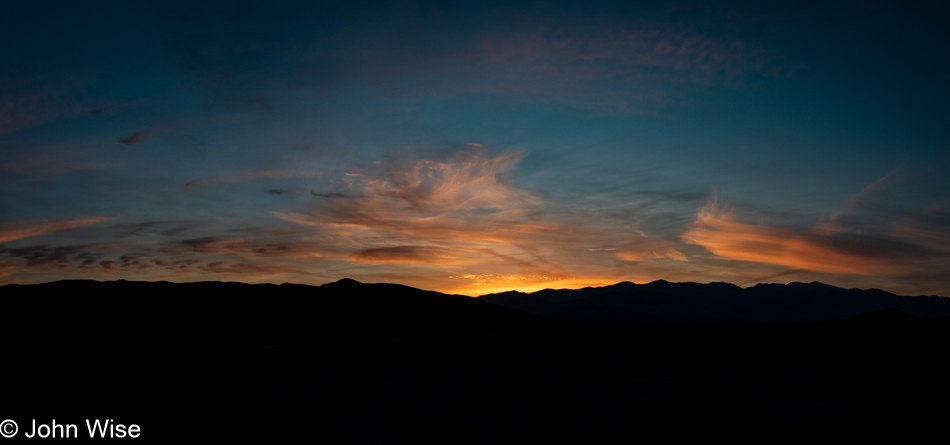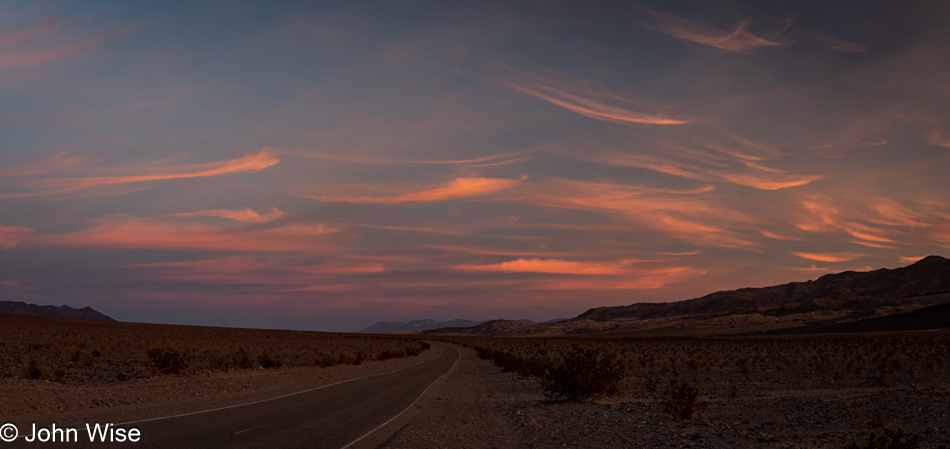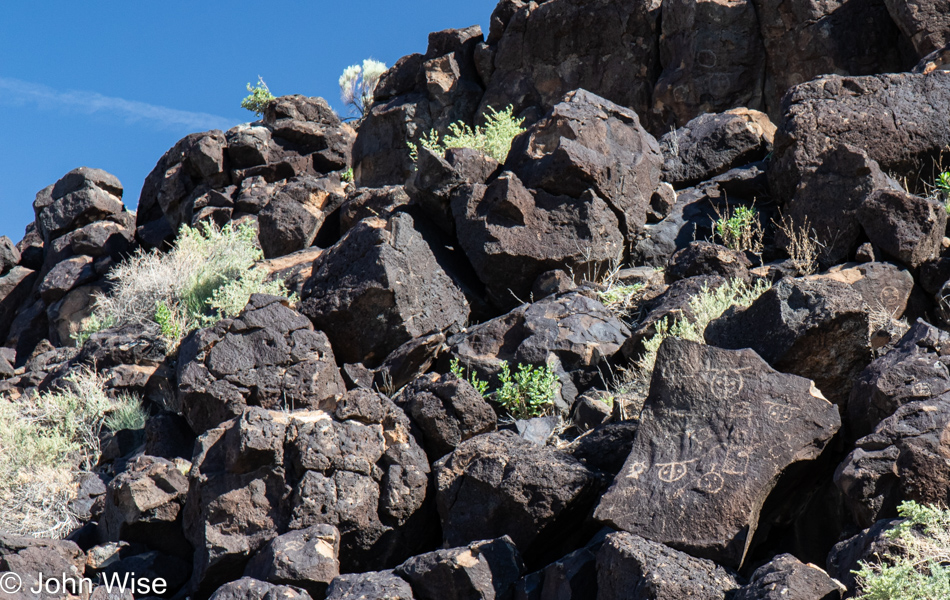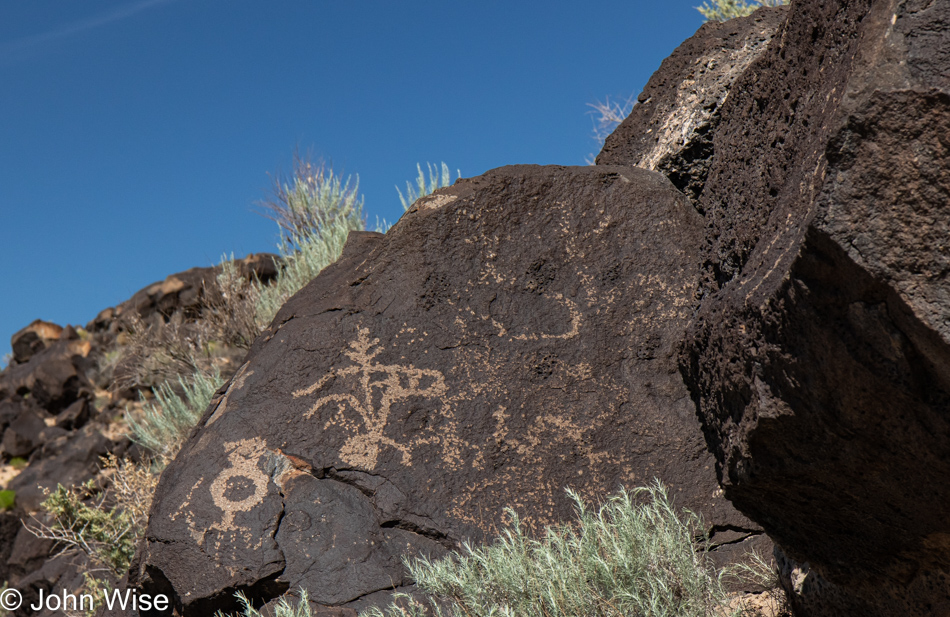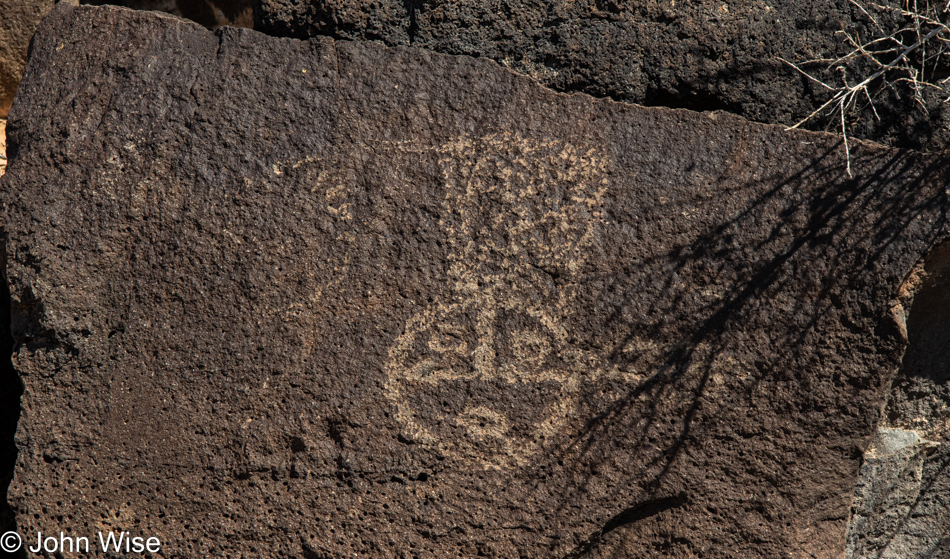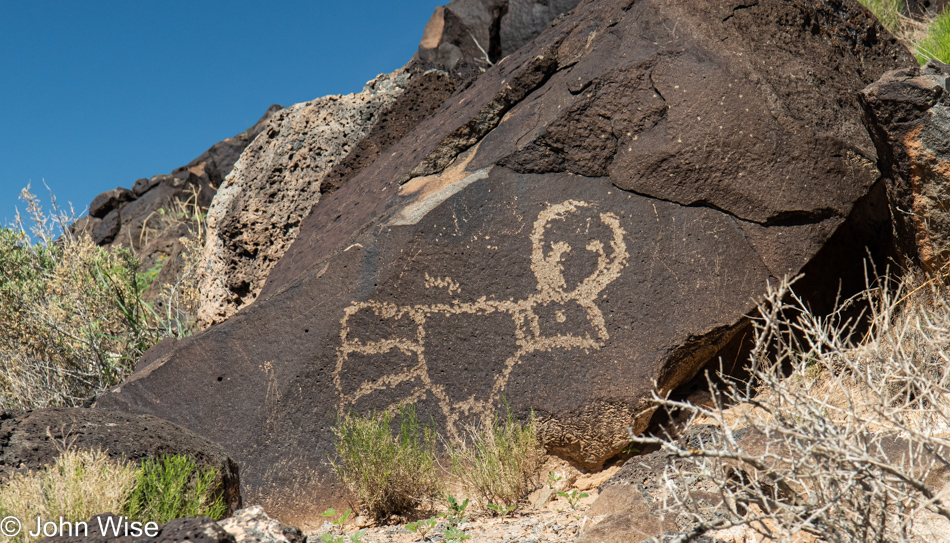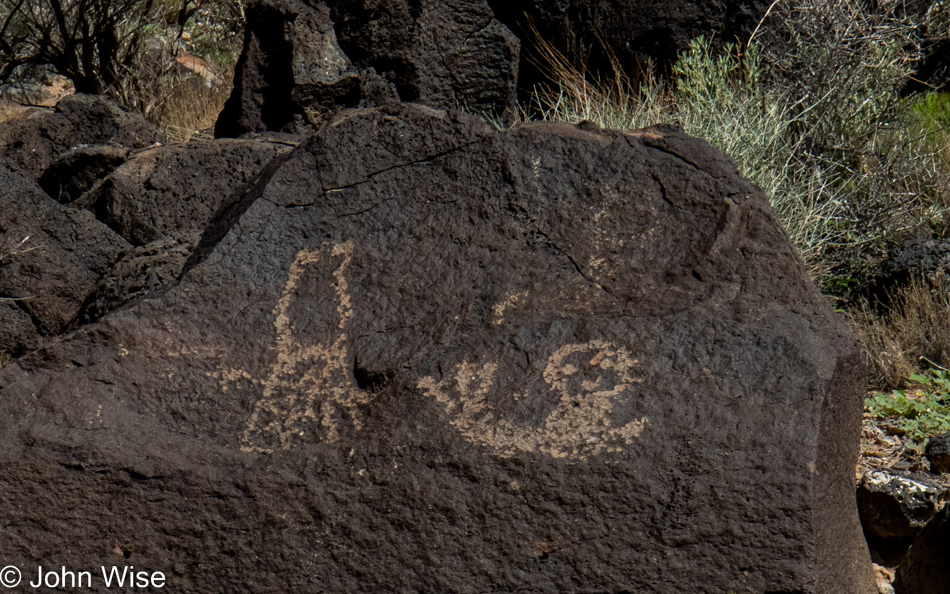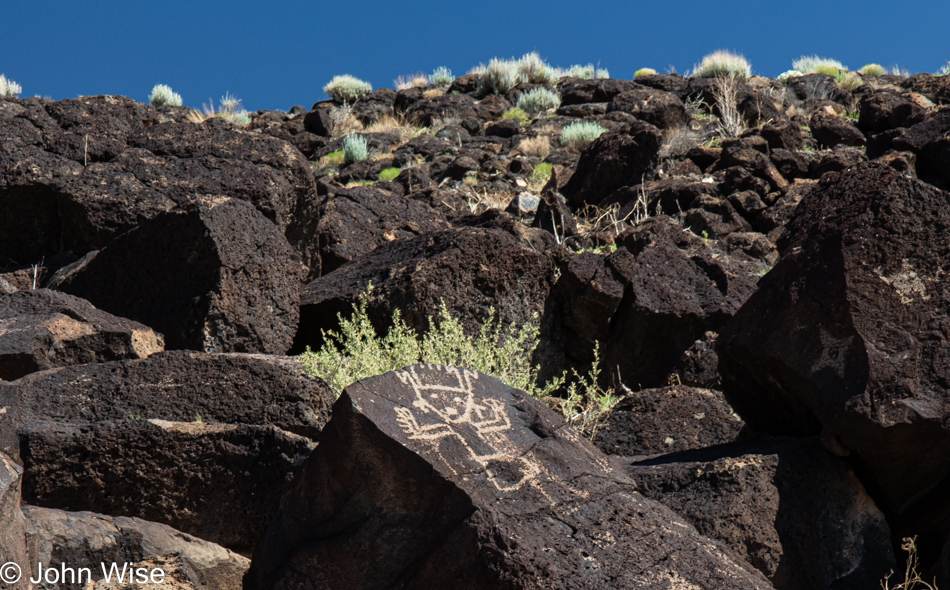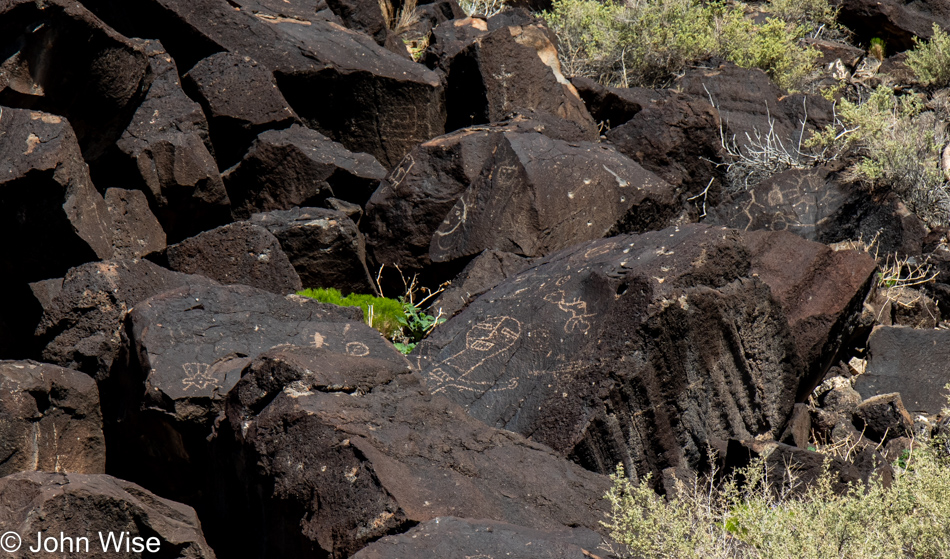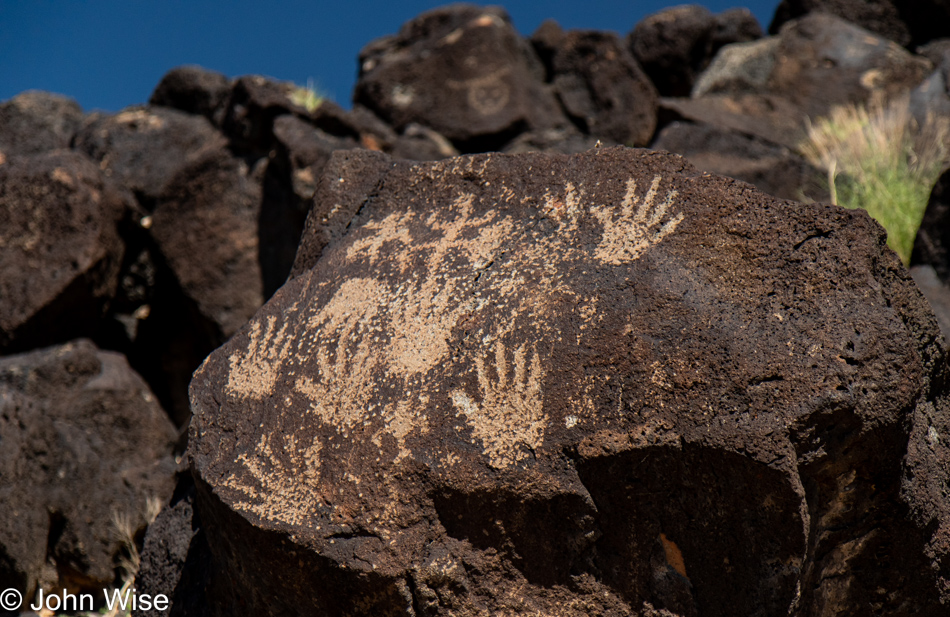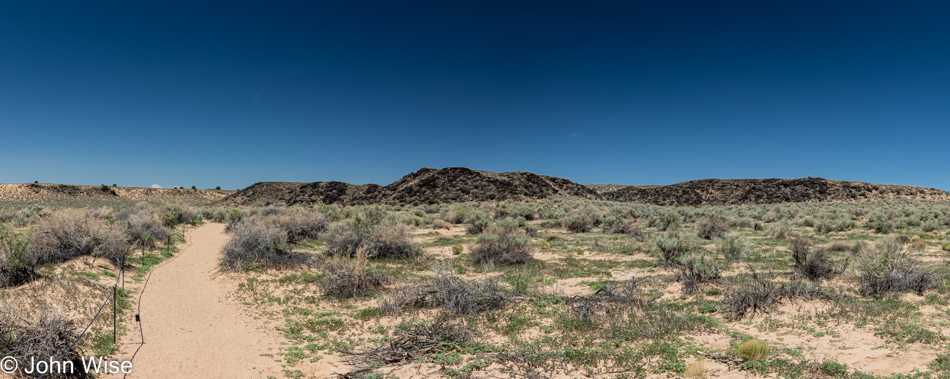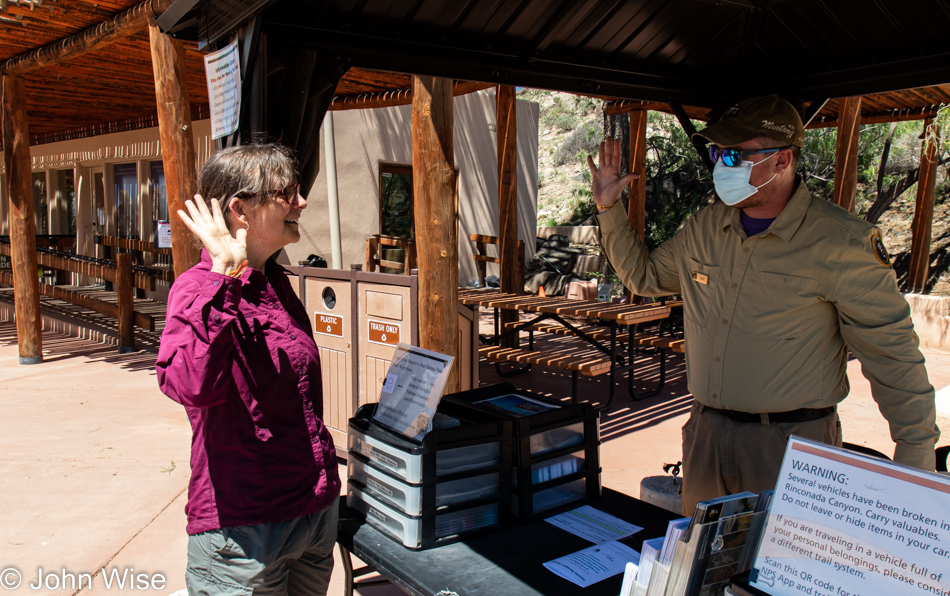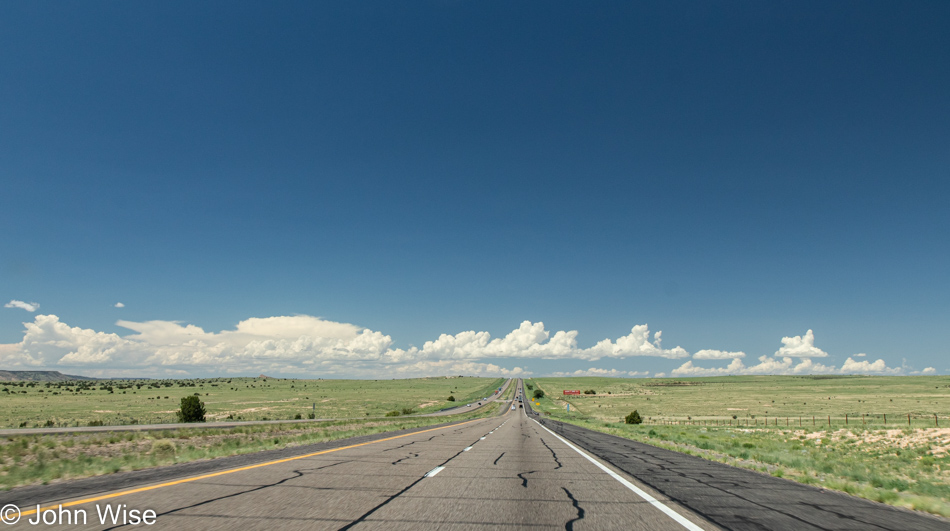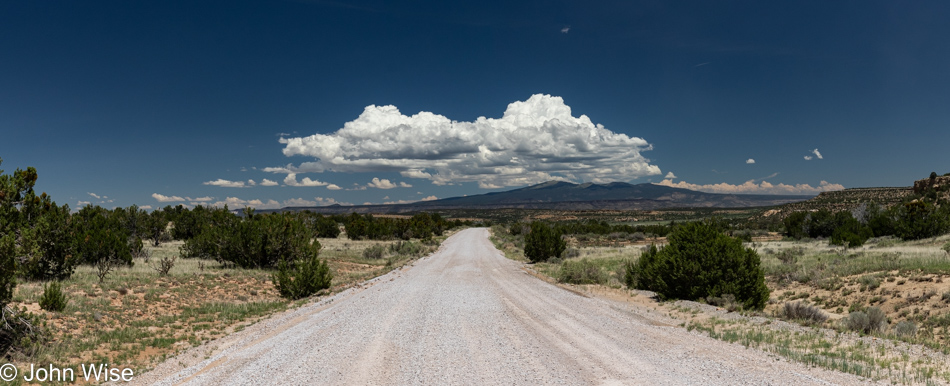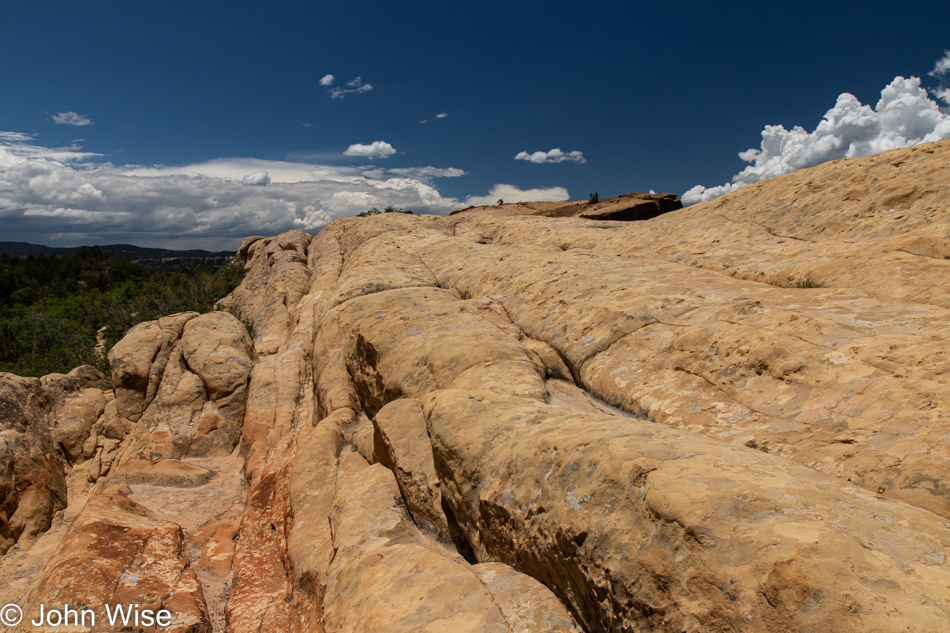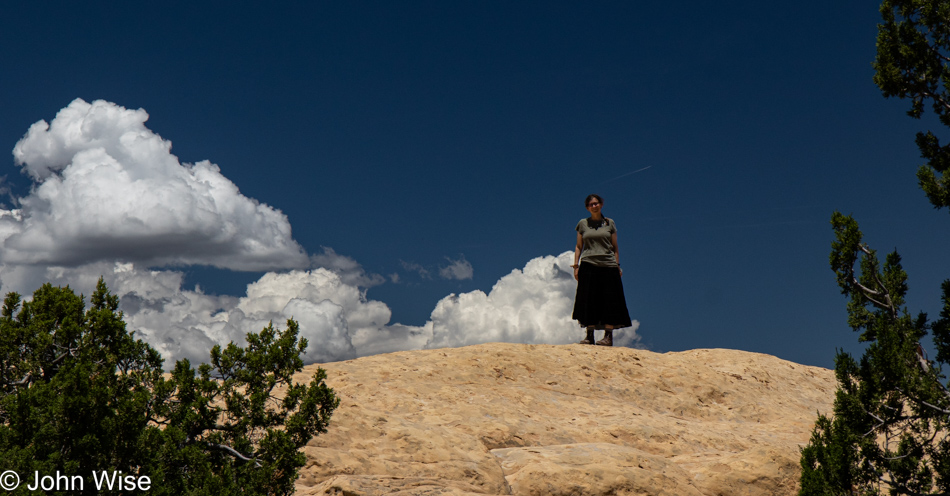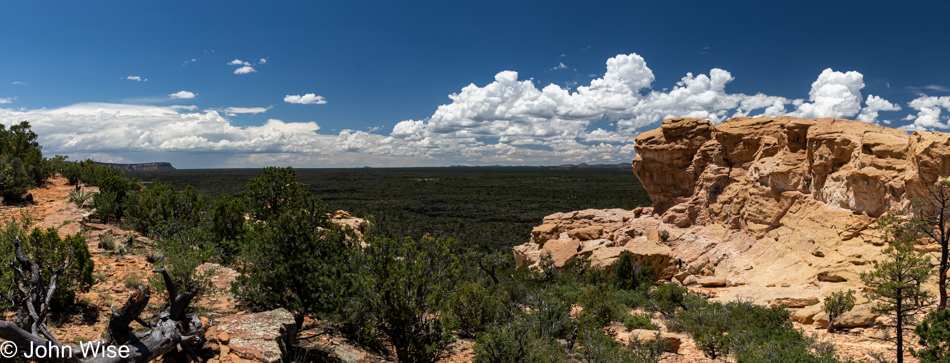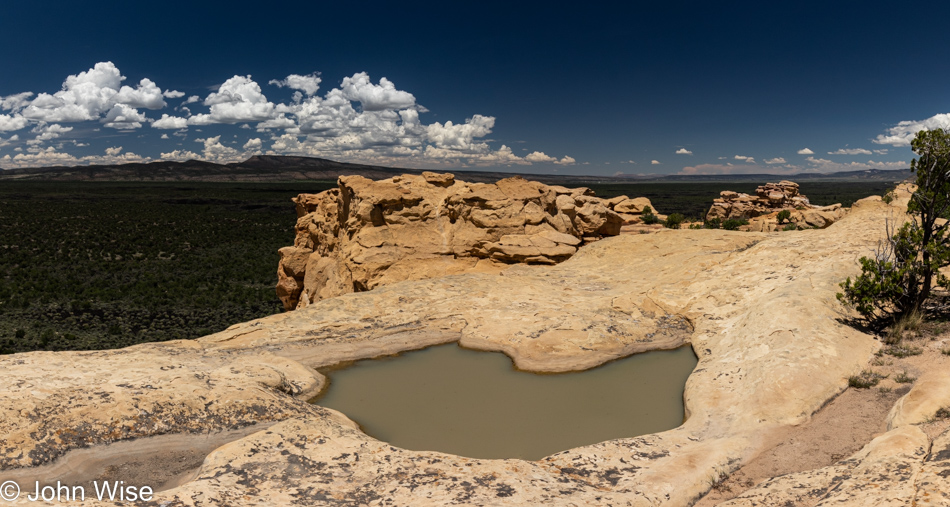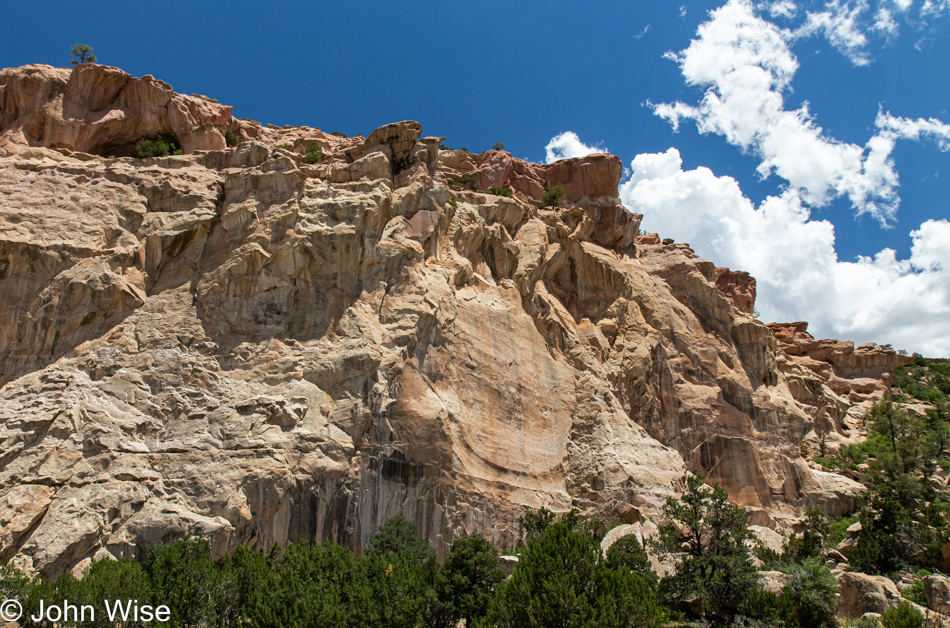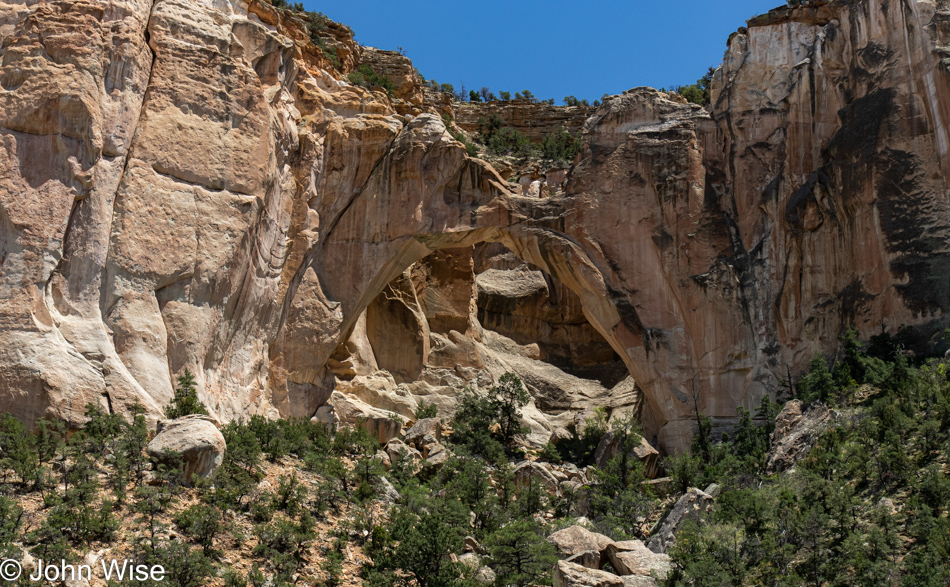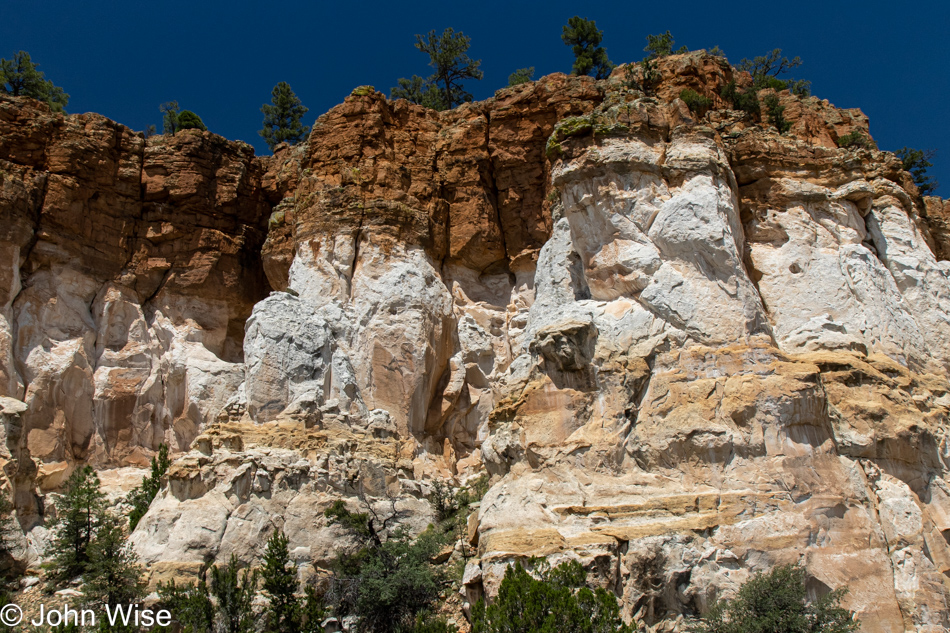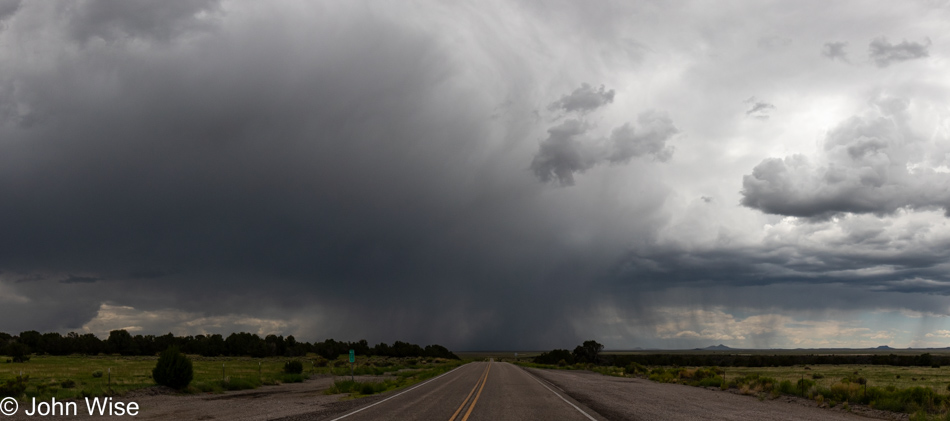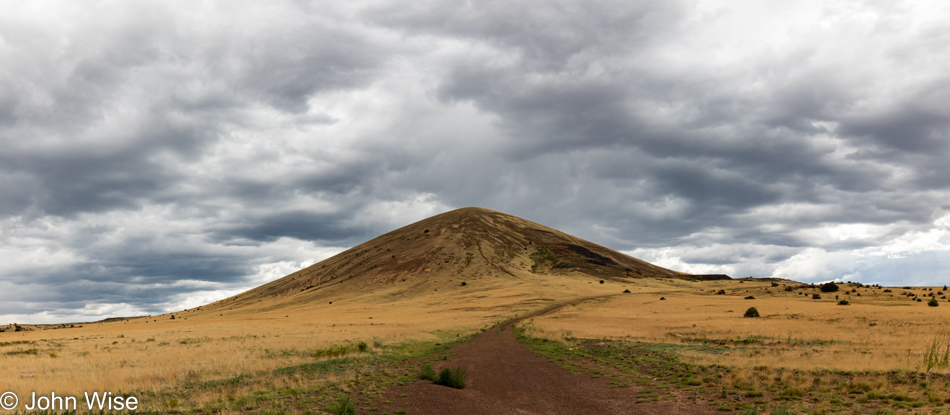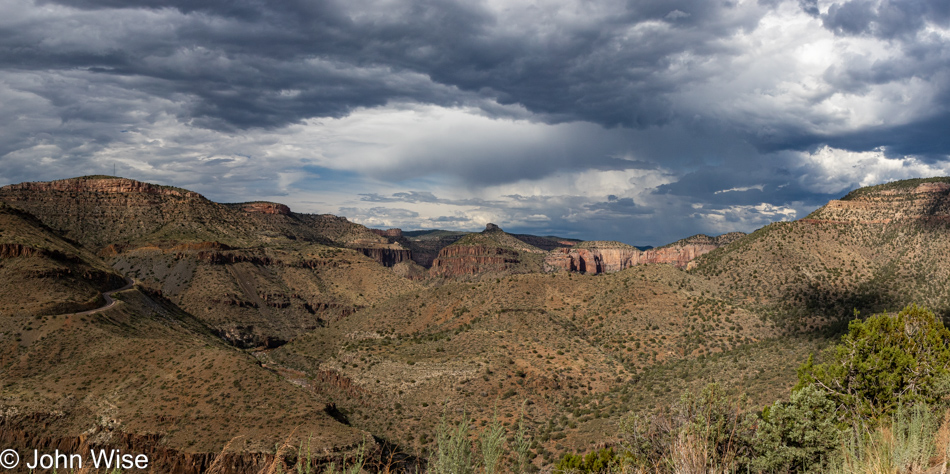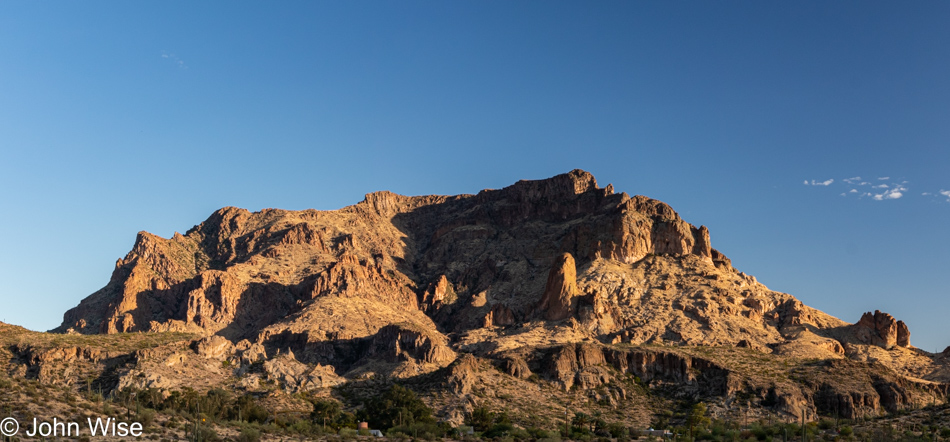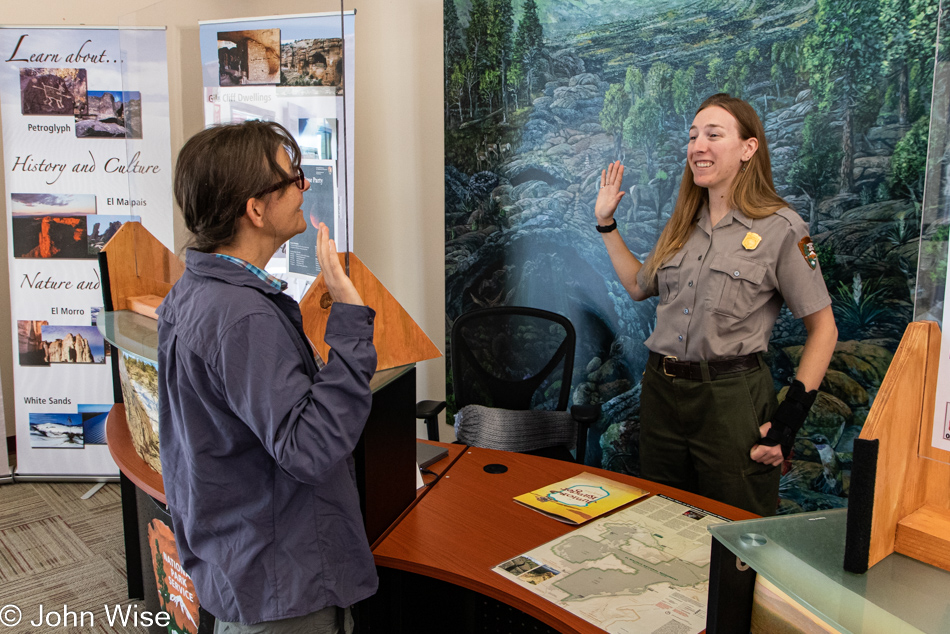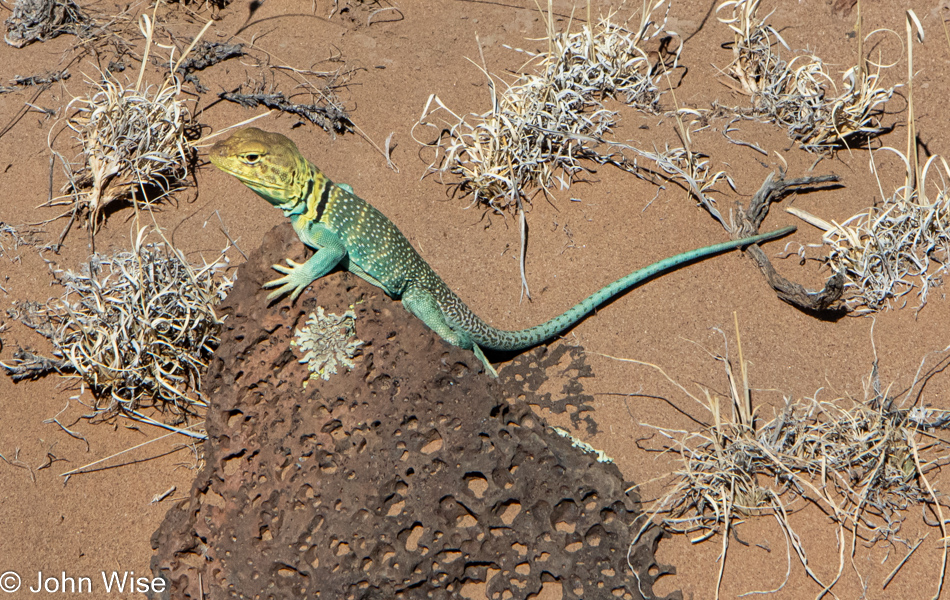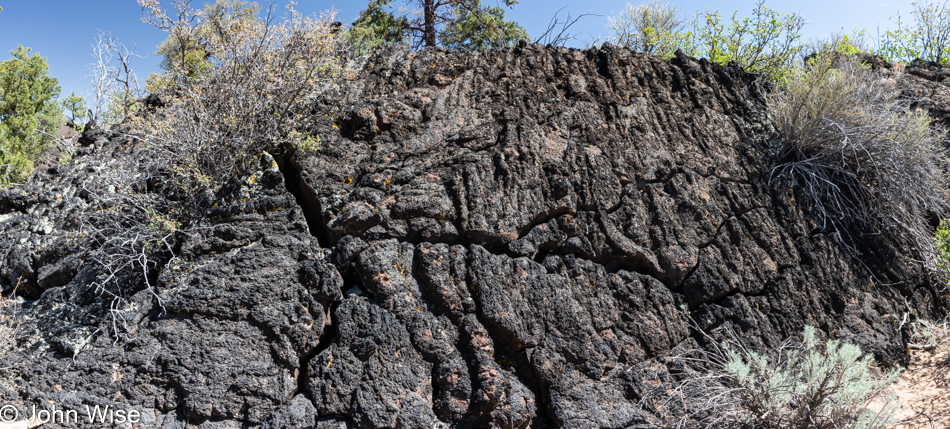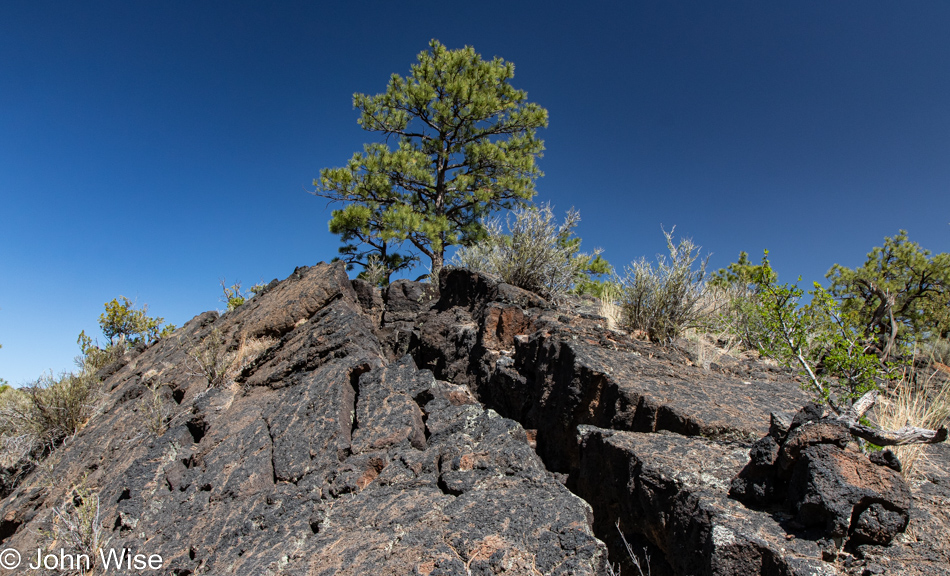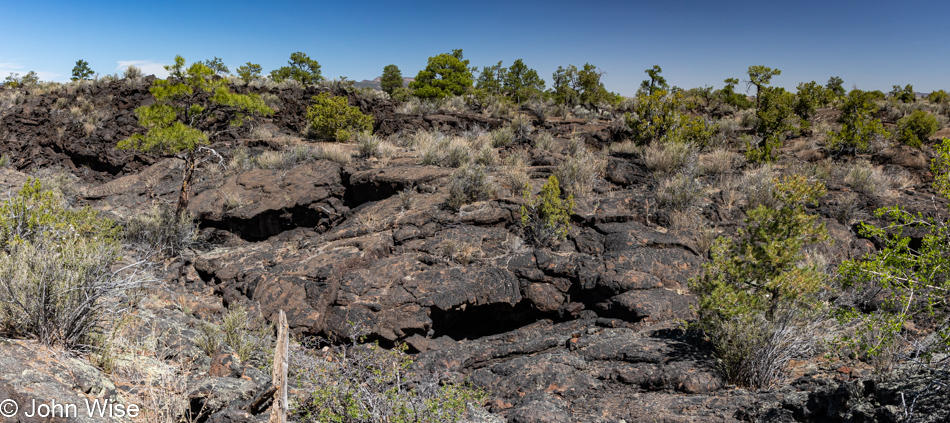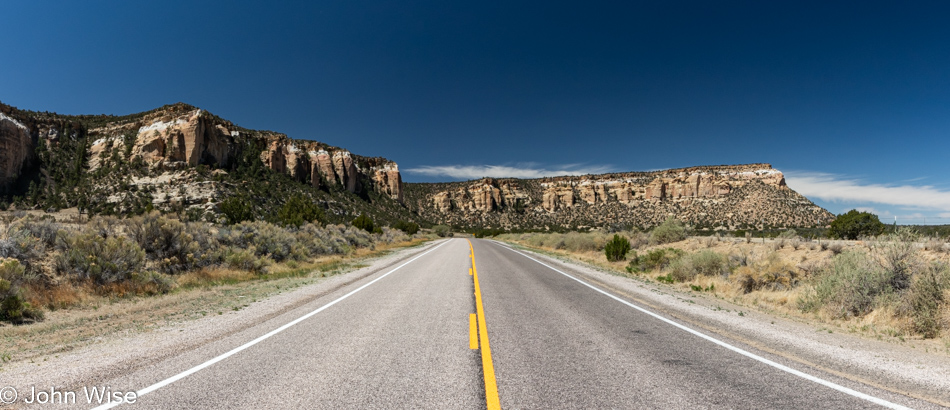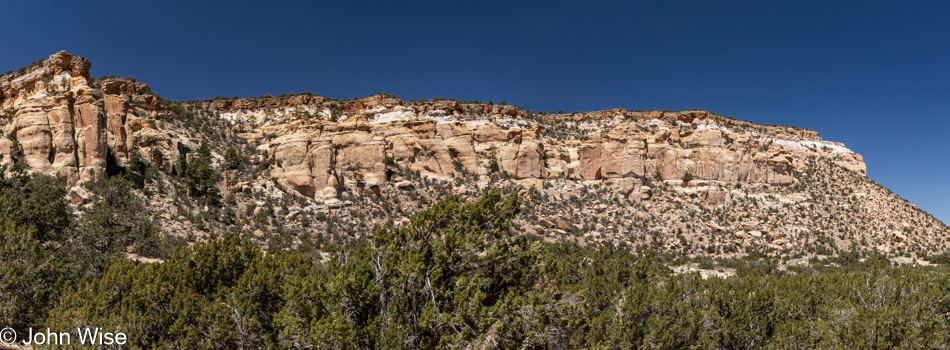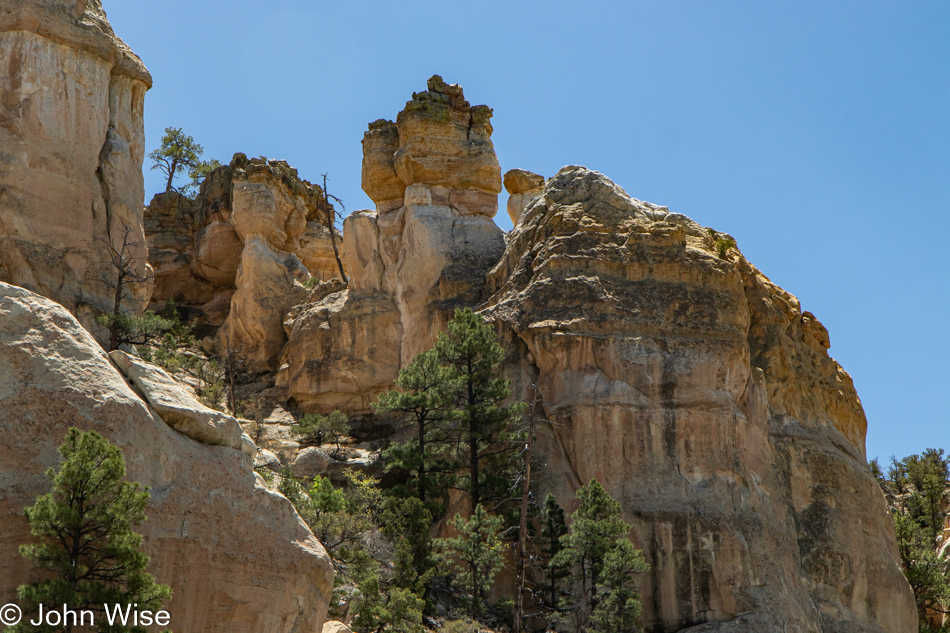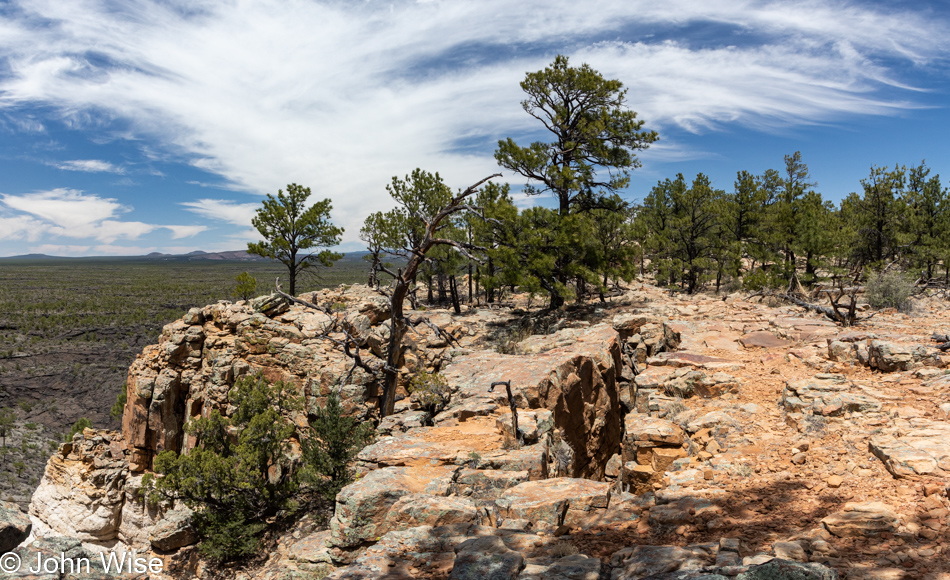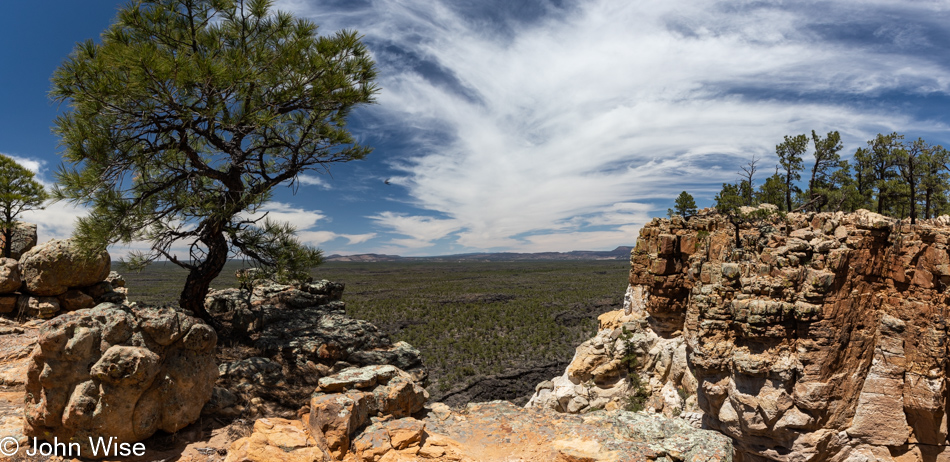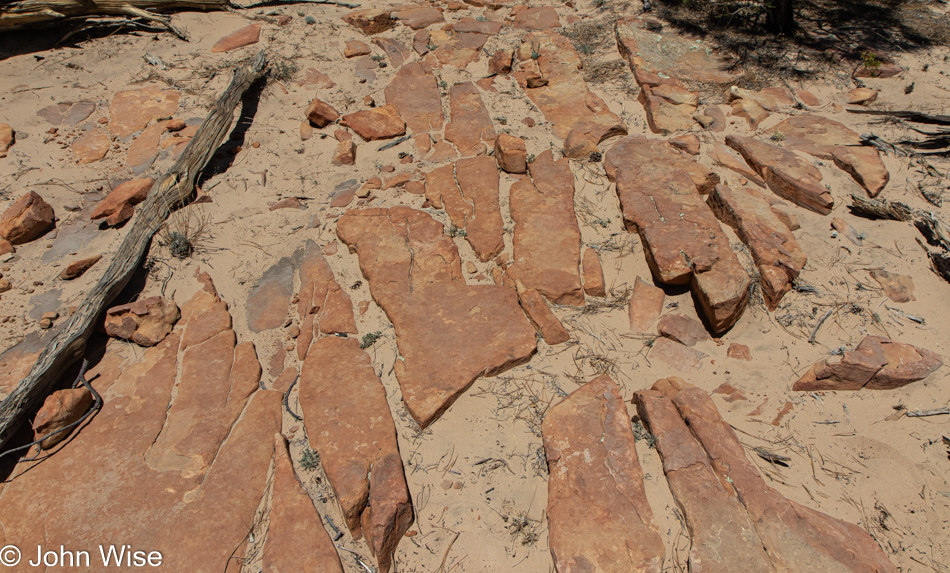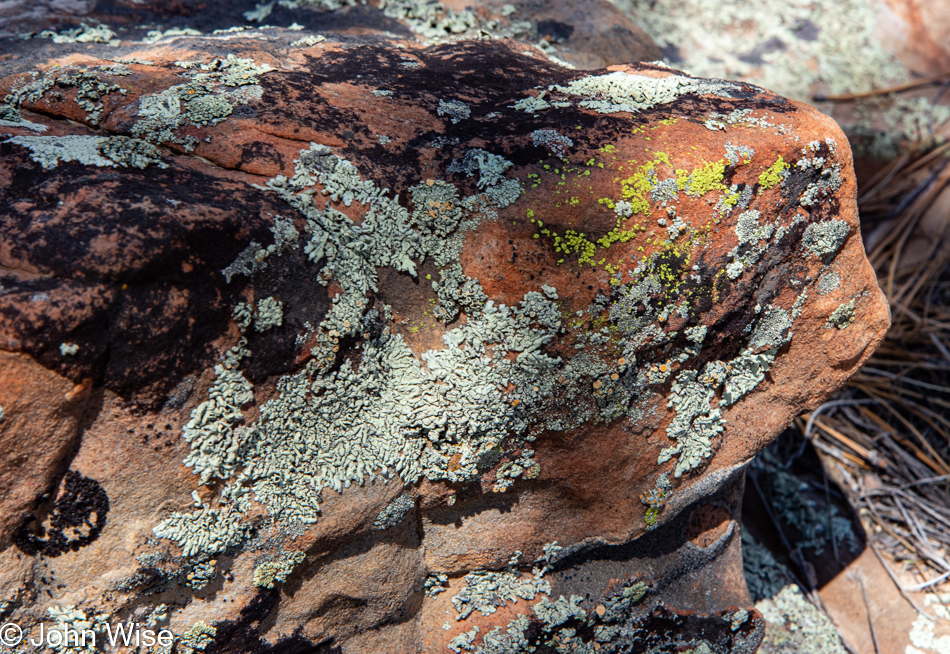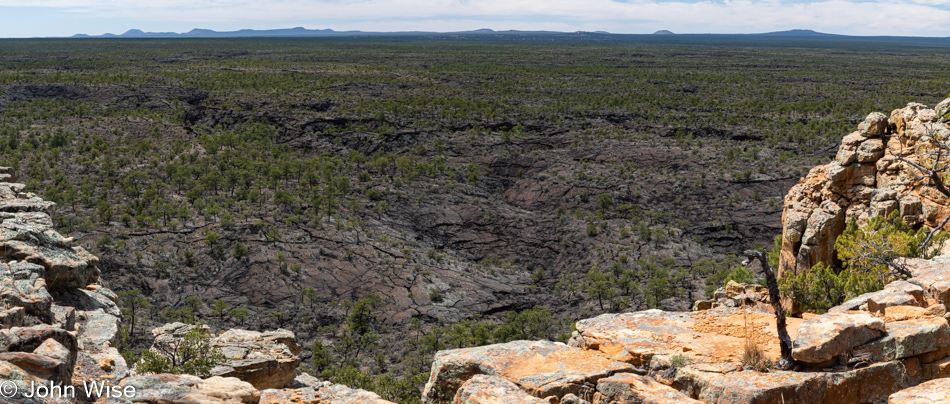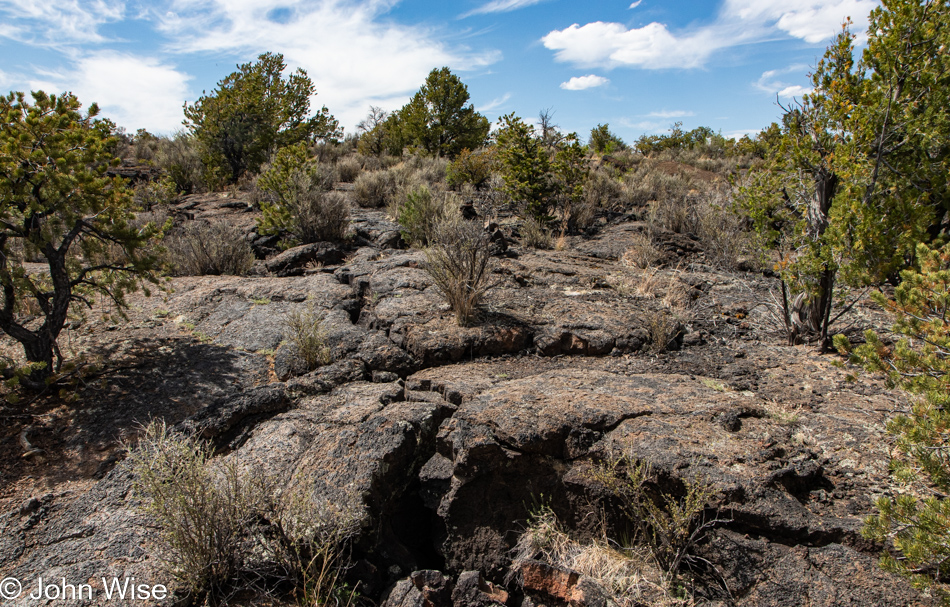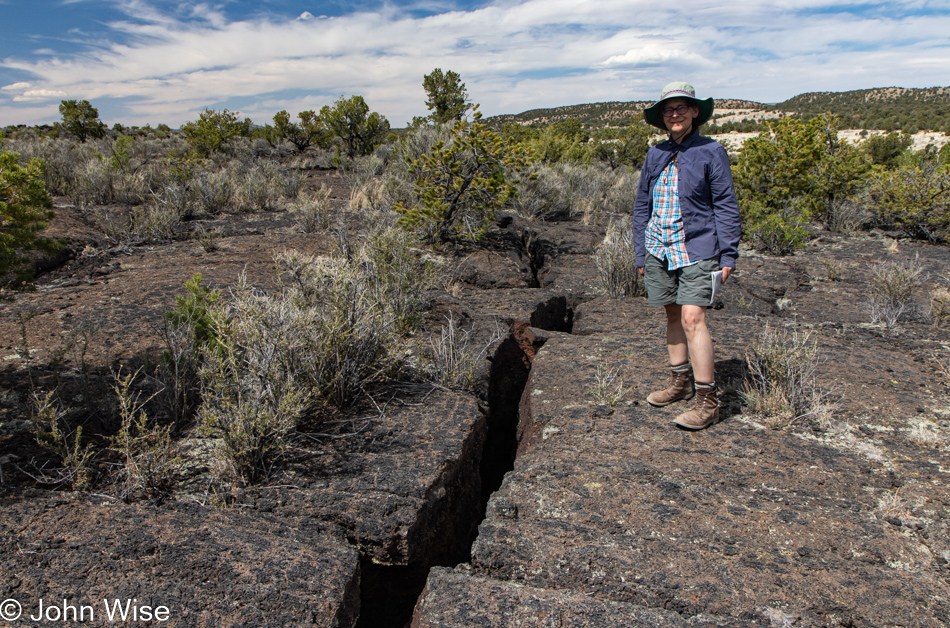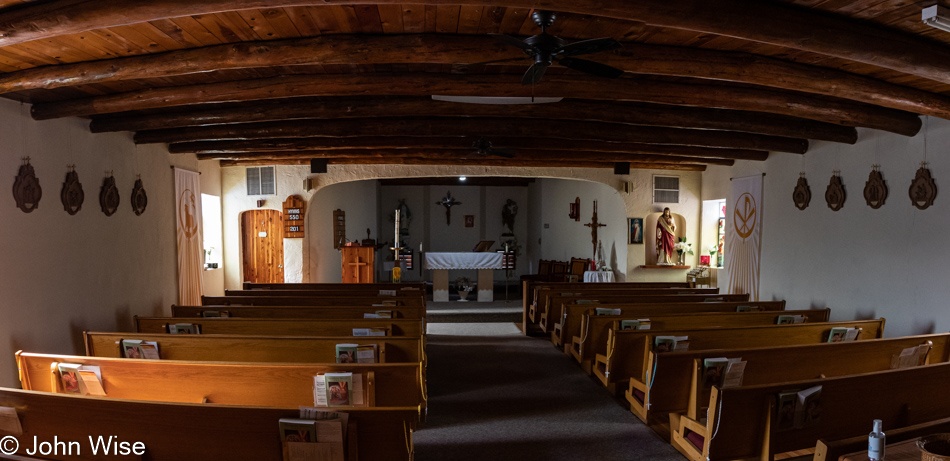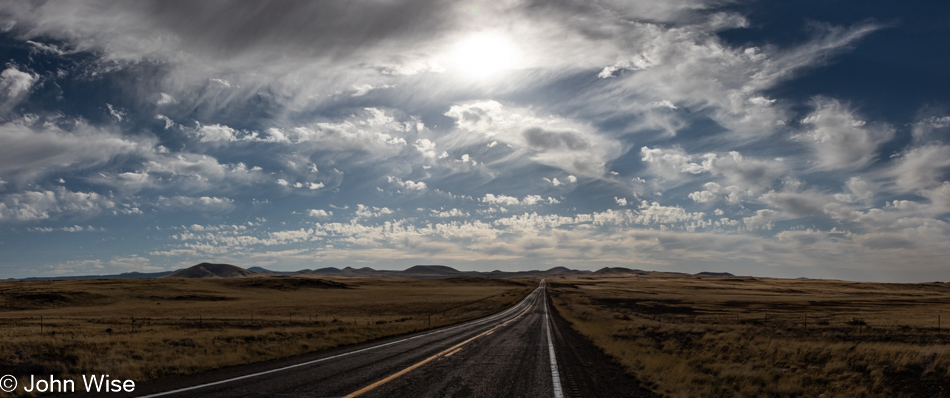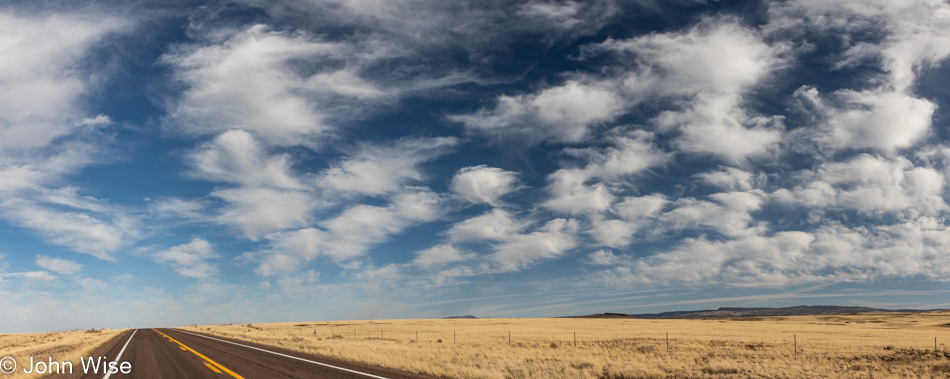
This is not a photo of mulching, but nearby, there was a sign announcing that mulching of the roadside was taking place, had taken place, or would take place, and that got Caroline to wondering why Canada mulches their roadsides while the United States mows them. So, upon getting home, I asked Claude 3.5 Sonnet (one of my go-to handy-dandy AIs) what its thoughts were, and it shared ideas about nutrient return to the soil, better resistance to erosion, a better wilderness aesthetic, and potentially better-insulating properties during harsh winters. Then, after consulting both Claude and Meta AI Llama 3.1-405B about the composition of the photo, specifically the rock, it seems that there is a consensus that we are looking at granite, which they say makes sense considering this is bedrock from the Gander Geological Zone that was exposed in cutting the Trans Canada Highway. I also inquired about the thin topsoil, which they said was consistent with an environment scraped down to bedrock during the last glacial period when the ice was retreating and finally disappeared between 7,000 and 9,000 years ago, which doesn’t allow much time in geological terms for topsoil to collect.

I can’t explain this as I’m unfamiliar with Canadian culture, but why the country adopted the nickname of Joey for Erich Honecker, the General Secretary of the Socialist Unity Party of East Germany, baffles my imagination. Maybe back when Canada was part of the Communist Bloc countries during the Cold War, Honecker visited Newfoundland and stood here, kind of like in 1976 when Queen Elizabeth II visited the Trinity Church in New York City, which was commemorated with a plaque noting her visit. Hey, Newfoundland, I was only joking. Joey’s Lookout was named after the former Newfoundland Premier Joseph R. Smallwood, who was born in Gambo. He was called the province’s “Father of Confederation” after bringing Newfoundland into Canada. Funny enough, Joey, as he was affectionately known, worked for the socialist newspaper The Call while living in New York City.
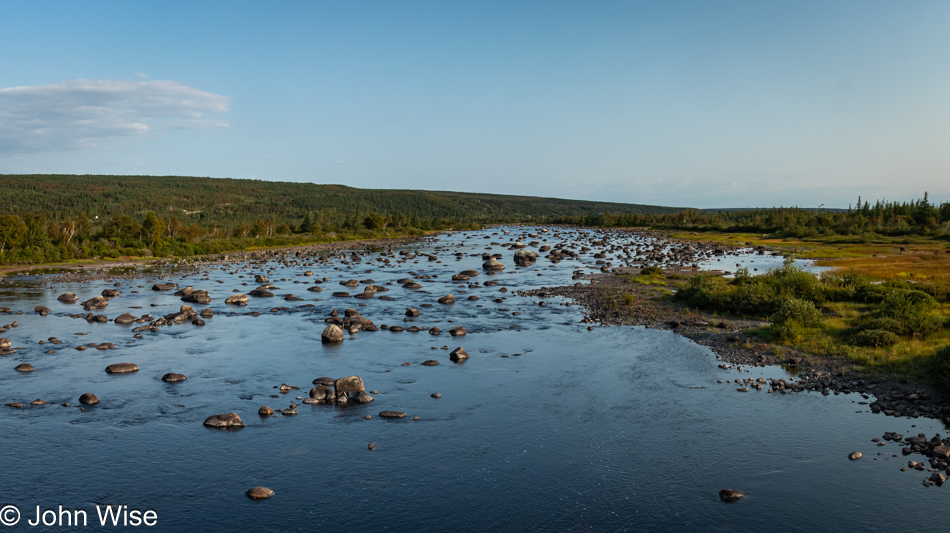
From the moment I saw the view from the overlook, I was intrigued by what lay below, but we had places to be, so we kept going. That was until we began to cross the Gambo River, and I turned around for a better look at the rock-strewn riverbed. While maneuvering, Caroline found a smaller road that might take us right by the area we were looking at from the overlook, so we had to go. This little detour is now responsible for ten photos in this post, thus helping push the total to 55 images, which promises to make for an extraordinarily long blog entry.
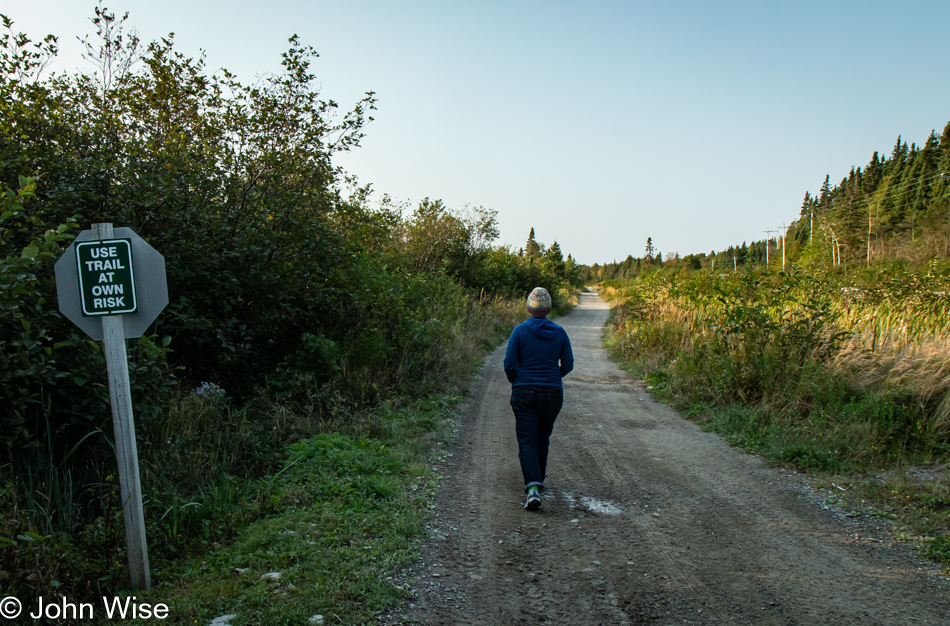
I had to wonder when we parked the car what exactly the sign “Use trail at own risk” was warning us about. Just what is ahead that warrants such a sign? Have I seen such a warning before on other hiking trails?

For the sake of brevity, I’ll try to keep the verbiage regarding the following photos to a minimum, as what can be said about cattails? Well, we now know from experience: don’t pick these and take them home because there will come a time when the temperature and humidity reach a sweet spot that will have the cattail bloom, and you’ll come home to an explosion of cattail fluff, a lot of fluff I can tell you.

From the Aster family of flowers, pretty, huh?

A couple of dozen islands in the river channel made the view from the overlook so interesting.

With my jaw agape and eyes peeled, looking for the perfect beauty shot that stood out from all the other beautiful places, I scoured the area, trying to determine the best range of colors and textures of surfaces. It is only now, back at home and writing these posts, that I can understand that part of the attraction I couldn’t appreciate while in Newfoundland was the relative uniformity of the ground reflecting the work of those glaciers that have created the conditions for the land to appear as it does.

Maybe I’ve seen similar things in other locations, possibly in Alaska or Wisconsin, I’m not sure, but I can say that after witnessing countless terrains and ecosystems that have shared an incredible diversity of life, colors, shapes, contrasts, and challenges to my senses, everything is forever feeling new like they are greeting me for the first time.

Sure, the focus is on the aster, but I also hoped the shallow depth of field allowed the lichens to show through, and while difficult to make out, I’m guessing that the rock is something found in the area called amphibolite.

Maybe I’m looking at biotite gneiss or schist; I can’t really know, seeing how I’m not a geologist, but I’m certainly a curiologist.

This old bridge is a remnant of the railroad that once ran across Newfoundland, but in 1988, after suffering years of financial losses, the Trans Canada Highway made it fully obsolete, and on September 30th of that year, the last train made its final run. This is also the end of our detour, but not before I note that the old railway line was converted into the Newfoundland T’Railway Provincial Park that runs from St. John’s to Channel-Port aux Basques with branches going to Bonavista, Carbonear, Lewisporte, Placentia, and Stephenville, thus creating a trail system that is 549 miles long (883 km) and suitable for hiking, snowmobiling, or mountain biking. A couple of days ago, Caroline noted that we spoke with a couple at the Lobster Cove Lighthouse in Rocky Harbour. Something they shared was their lament that they’d only visited Newfoundland for the first time the year before and now wished for more time to explore the island, which brings us to Reason #8 for a return that might be an impossible dream: riding the length of the T’Railway while balancing other obligations, curiosities, and the fact that we are aging. Reading our notes at the bridge, I’d be amiss if I didn’t share that we were just as quickly gone from there as it was extraordinarily windy, but not before we spotted a seal spying on us from the water.
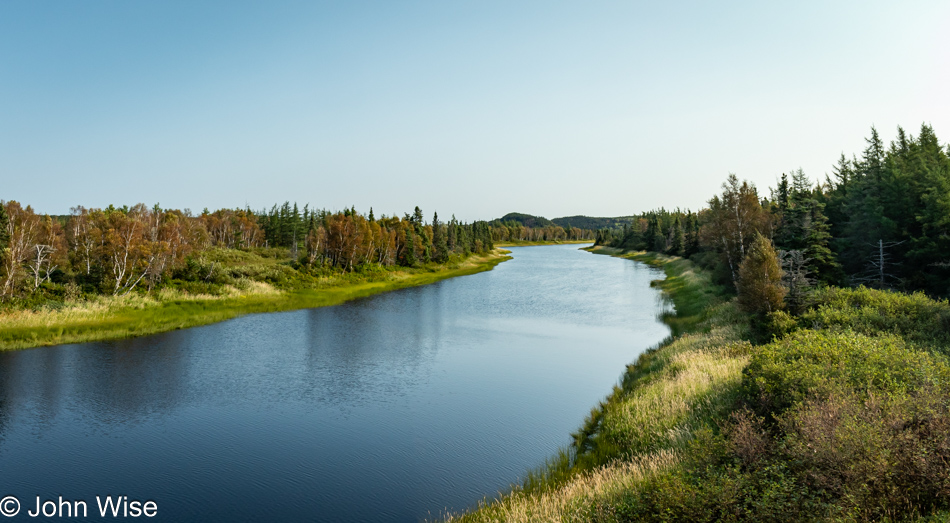
Crossing over the Terra Nova River means we are only a couple of miles from the border of Terra Nova National Park and about ten minutes from its visitors center. Regarding this name, Terra Nova is Latin for New Land and was the original Portuguese name for the island.
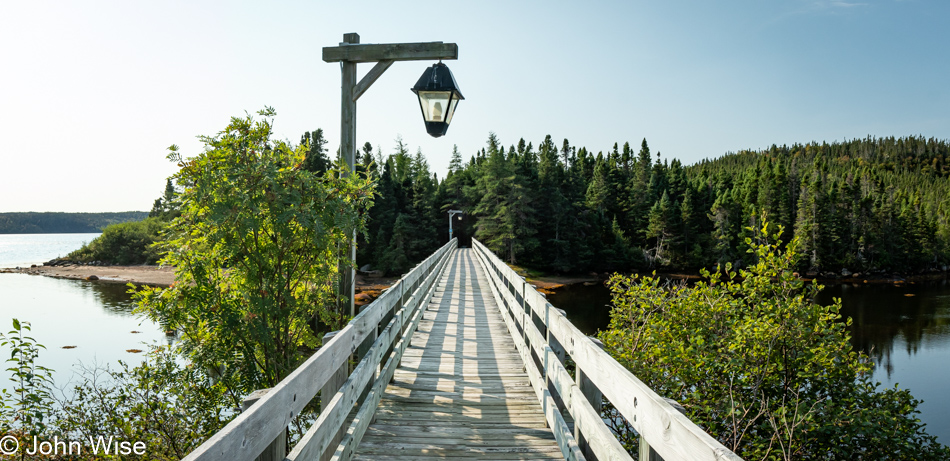
I’ll never remember the woman’s name at the visitor center who helped us navigate the course of our visit, but I hope never to forget how incredibly friendly and enthusiastic she was about guiding us into a course of exploration that would make for such a memorable day in the Terra Nova National Park and allowed us to gather the best sampling of the diversity found here.
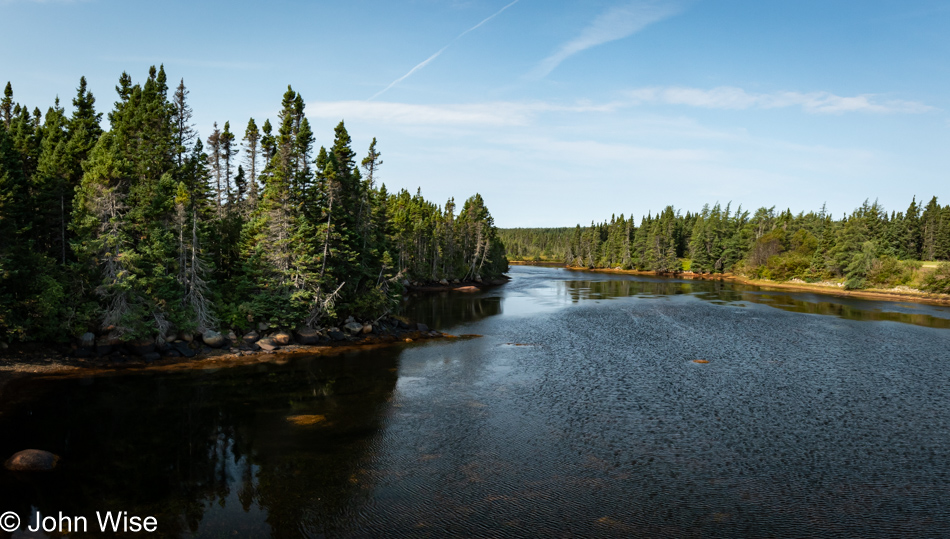
At Newman Sound, we crossed a small arm of a much larger arm leading to the Atlantic Ocean while walking over the bridge pictured above this photo. This is one end of the Coastal Trail, a 5.9 mile (9.5km) out-and-back hike of which we’ll only be exploring a small part for a quick impression before moving on.

We walked about a half-mile along the coastal inlet before turning around and heading to our next location.

On the north side of the visitors center, we explored the Goowiddy Path, which was supposed to lead us to an interesting feature a short way up the trail. Goowiddy is a Newfoundland word for low shrubs.

That area of interest is what is called a Barachois, which means a sand or rock bar that forms a lagoon. It was the recommended end of our walk here on the Goowiddy Path, which has been popular with birds, especially a couple of kingfishers, which we were lucky enough to hear before seeing them fly off. This bird is more likely a sandpiper as the willets have typically migrated by the end of August, but we can’t really know as this is all we saw of this little guy.
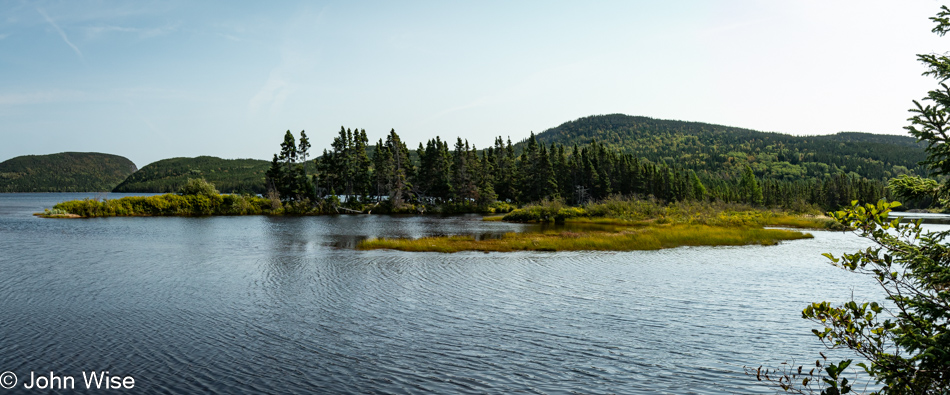
From that obviously busy and overcrowded area near the visitor’s center, we made our way to the Southwest Arm Trail, where we did not encounter another person. The truth is that we didn’t bump into anyone else on the Coastal or Goowiddy Paths, either. This national park is pretty quiet at this time of year.

Here it begins: the trail, the mottled sunlight, shadows, and shades of greens, grays, and browns conspire to pull us into a trance. The visual song of the forest is a lullaby that brings us deeper into ourselves as we sink into the environment.

To linger here and return again and again, even if only by photos and words, is the clear objective of giving in to the seduction such places can affect upon those of us with inclinations towards being in love with the world when for a short amount of time, we have escaped the chatter of minds concerned with things human and are returned to being one with nature.

The beavers that built this pond are not concerned with yesterday or tomorrow. They, by their nature, live in the moment where the instinctual tasks demanded by their existence allow them to tend to a life with purpose in a universe shaped largely by their actions to sculpt such places.
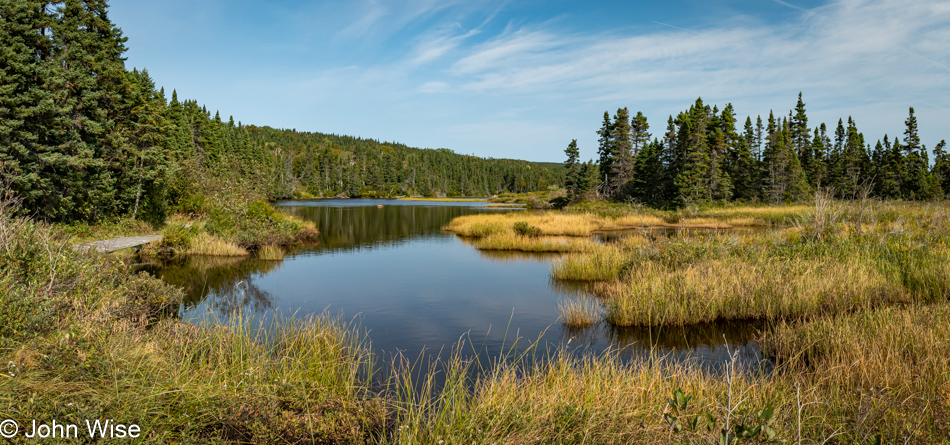
Our opportunities to escape the noise within our heads are rare. Even when looking out upon perfection, there’s often a critical mind that, through our ignorance, suffering, or other afflictions, we cannot escape those situations to allow ourselves to fall into these scenes. Those who kayak these waters, fish, and camp along their shore are the fortunate ones. They are returning to the solemnity of presence after having learned the important life lesson: this is what feeds your soul.
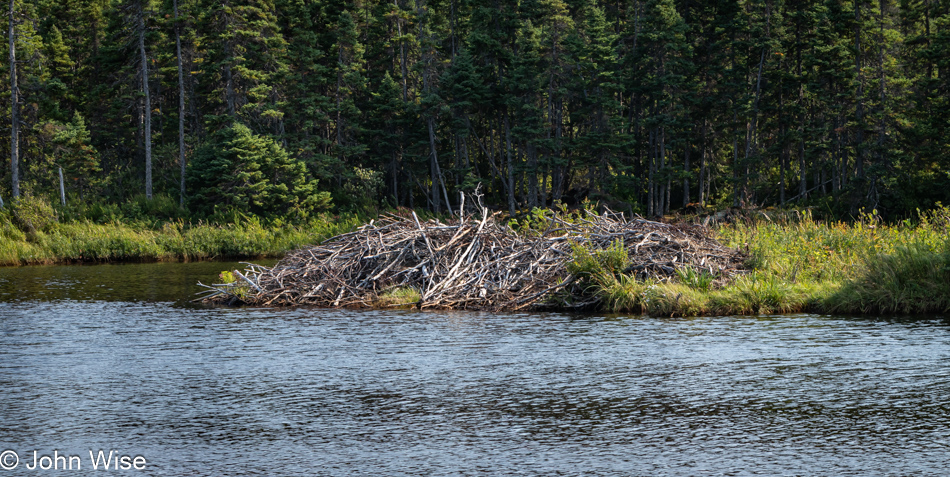
Somewhere under that entanglement of twigs and branches is the palatial mansion of a beaver family in whichever way that is configured in their kingdom. I don’t know that I’ve ever seen such a grandiose beaver lodge, but I’d wager that if I were a beaver, I’d feel like the winner of the billion-dollar lottery and that I was living on easy street.

Come to think about it, here Caroline and I are in the rare position of finding ourselves 3,988 miles (6,418km) from home, standing over a lush green carpet of moss. At previous times in human history, it would have required no less than 235 days to walk here, and that would be with the availability of a trail, ease of finding food and water, and weather that would have worked in their favor. Instead, people can come here from just about anywhere else on Earth in fewer than 24 hours to enrich their lives, should they begin to understand what the attraction to such sights can do for them.

Missing one wing and completely motionless, we thought that this dragonfly was dead; that is until I got closer than this, and those wings started buzzing as it lifted off the boardwalk and moved on to somewhere else.

If my puny brain worked on my behalf with the rigor I’d like to exercise, I’d share a story here of the infant slug and mushroom that would carry a valuable lesson loaded with knowledge as important as any of Aesop’s fables, but my abilities fall distantly short of manifesting that type of genius.

With this image, I bring you to the end of our visit to the Southwest Arm Trail.
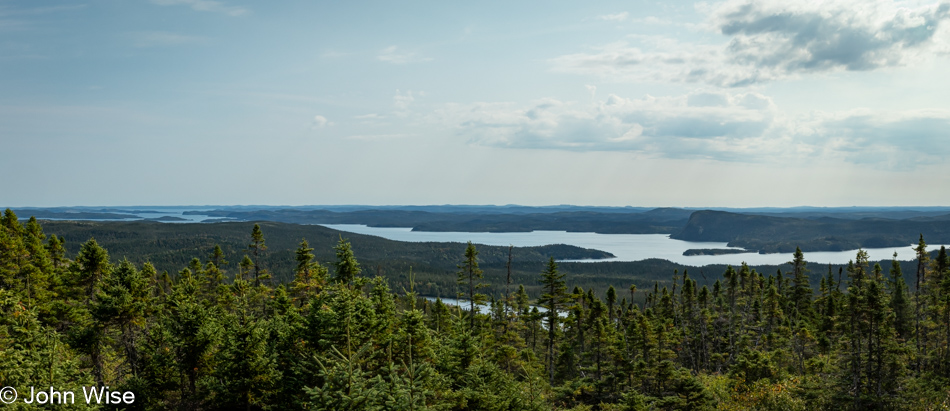
This is the fourth destination we visited in the park today, the Blue Hill Overlook. The view looks out over the boreal forest of the park, and the sliver of water towards the foreground is the Blue Hill Pond, while the larger body of water is the long finger of the Atlantic Ocean reaching far inland from the Bonavista Bay.

We’ve found these Muskoka chairs seemingly everywhere as we travel through the Maritimes, and while Americans might want to call them Adirondack chairs, the Canadian version has a curved back (yolk), distinguishing it from the American variant.

Need a mountaintop privy? Caroline did, and this outhouse served its purpose. Strangely, there was no sign pointing out that this toilet was nestled away for the convenience of visitors back in the trees. I didn’t peer in, so I can’t share what one should expect in a Canadian outhouse in a national park, but Caroline has that first-hand experience. Maybe she’ll tell us a thing or two about what to expect at the end of summer. [All I can say is that it was in good shape, not bad at all. – Caroline]

We are back on the Coastal Trail, but at the other end, where the Pissamare Falls are located.

By the time we leave Terra Nova later this afternoon, we’ll have walked approximately 7 miles (11km) of the trails in the park, leaving about 42 miles (67km) of trails to explore should we return to Newfoundland. Is this Reason #9? Let’s ask Caroline. [I’d love to come back and, this time, climb all the way to the top of the… oh wait, we’re not there yet! Keep going, gentle reader. Caroline]

Our second-to-last destination for the day is the fire tower at Ochre Hill. When we arrived at the tower, it was a bit more overcast than seen here, but the sky had time to clear while we talked with a German couple who’d been traveling around North America for months in a camper van they had shipped over from Germany. After talking with them for a solid half-hour, another couple came walking around a corner, who also turned out to be Germans. There we were, five Germans and an American, not a Canadian in sight – what are the odds? [Even funnier was that they were all from Bavaria – Caroline] Before leaving, Caroline wanted to go up the tower. She made it two-thirds of the way before the metal grating that allowed her to see the ground below and the strong winds convinced her she’d seen enough. The photo of the view she took is terrific on her phone, but should you want to see just how terrific it is, visit Terra Nova for yourself. It’s well worth the effort.
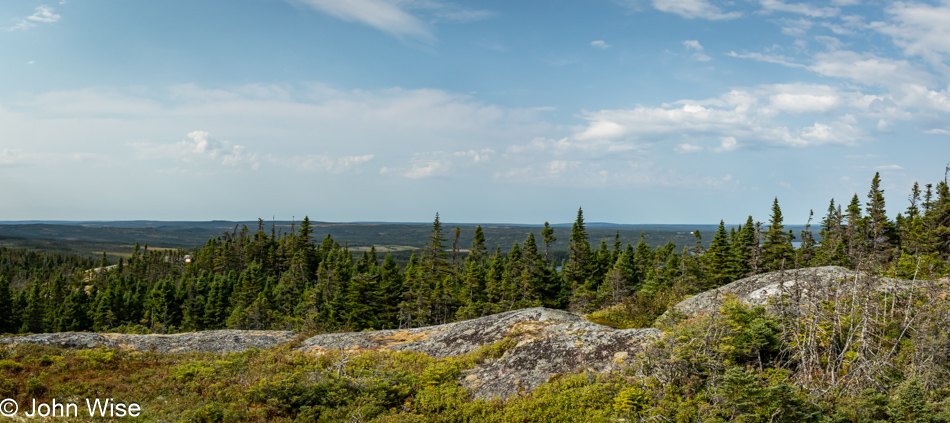
My fear of heights stopped me from stepping on that tower. There were witnesses below who might have noticed my display of fear. I preferred to be aloof and appear not to care about such things because I’m an idiot. This view sucks compared to what my wife saw.

On our way down Ochre Hill, this ruffed grouse was apparently trying to figure out life because right there on the road with our car heading towards it, it seemed to be contemplating its options. I expected the bird to skedaddle as I stepped out of the car and that my opportunity to get a closer shot would be lost, but no, it just moved around and continued to pose for my camera. That only lasted until I pressed my luck, trying to get even closer to capture more details of this gorgeous bird.

Our seventh and final location in the Terra Nova National Park today is at Sandy Pond, where we encountered another winged object of beauty, this red admiral butterfly. I suppose this place right here is a good spot to note that a few days ago, Caroline learned of the passing of her dear friend, Sandy Gally. The two met on August 8, 2008, at a natural dying workshop in Blue, Arizona, and have been friends ever since. Sandy had experienced health issues for some time, but still, like so many deaths, hers arrived out of thin air in some ways.

It took Caroline a few days for the news to sink in, and it was here in the park that she felt the first inklings of grief and the loss of her friend.

I just learned a lesson about writing. It’s difficult to come back from sharing information about a friend’s passing to the flow of discovery and delight.

Mortality, though, is an important topic, one that I’m well aware of and consider often, possibly too often. At 61 years of age, with some morbidities potentially accelerating my demise, I cannot ignore the significance that on my horizon stands an exit, hopefully, a distant one. That portal may not be paved with the verdant cover and abundance of life growing out of what has come before it, such as we see in the forest. My death is not of much concern to the inevitable state I will fall into, as I understand that any potential future will not include my presence at some point yet to be determined, but there is the matter of what I leave behind. I don’t mean the fertilizing potential of my ashes or remains; I’m more concerned about the woman who will find herself alone. True, the reverse could be my situation where unexpectedly, she departs before me, skipping out on the pain of being without the other who has brought so much shared joy into each other’s life. On the other hand, this is a futile exercise of thought, as none of us have figured out how to read the future, and we never know the fate that awaits us, even what tomorrow or the turning of the next corner has to offer.

For now, the next corner offers ferns in a light that begs for capturing by my lens and putting away those other thoughts that are, at best, amorphous and entangled in a complexity of threads that have no resolve.

If AI is to be trusted (and why shouldn’t it?), this lichen is likely known as Old Man’s Beard, and I suppose mine resembles this description, so I’ll go with it and state that unequivocally and without a doubt, this is Old Man’s Beard.

There are moments when we are on these trails and then again when we are at home looking at these images that we are absolutely incredulous that we were allowed to be here, that we had the wherewithal to place ourselves in such an environment, and that life has smiled so kindly upon us that this was our fortune. We are not millionaires; we have not inherited a thing, and we must sacrifice other things to bring ourselves into these rare experiences. How rare? Only about 40,000 people visit this national park annually, so just how many actually bring themselves out on this particular trail that is merely one of a dozen? It is more common in the United States to be a millionaire, as there are nearly 25 million of them, but we are part of that tiny group of 40,000 who know a fraction of the delights found here in Terra Nova.

Add to this that we are likely the only humans who have or will have ever seen these mushrooms, and this should inform you of the kind of wealth we collect. These are our unicorns, our genie in the bottle, the found diamonds in the rough waiting for our arrival.

Black spruce trees are a certain indicator that we’re in a boreal forest, also known as taiga. Dwarf plants and low shrubs make up large parts of the biome in these ecosystems due to the poor soil quality following the last ice age when glacial activity scrubbed these lands clean. Almost shocking for me was to learn that this type of environment is only about 12,000 years old, coinciding with those retreating glaciers and that they are the second in size only to deserts, covering 11.5% of Earth’s land area. Not only is the black spruce popular for making chopsticks, it is the provincial tree of Newfoundland and Labrador.

Recently, one of my social media feeds that drops random bits from history brought my attention back to Tollund Man, the 2400-year-old body found in the Bjældskovdal peat bog in Denmark, which had me thinking about our encounter with bogs (actually, I think we were visiting fens) and the sphagnum moss at their surfaces that is the most obvious indicator of the peat below. The difference between a bog and a fen is simple: a bog relies on precipitation for water, while a fen receives its water from the ground or accumulating flows draining from a slope or accumulating in a depression. This took me on the chase to learn more, and I found that these types of moss contain antimicrobial phenolic compounds that are high in acidity, have tanning properties, and are conducive to preserving things, including peat itself. Without peat, whiskey aficionados wouldn’t enjoy the same drink, some cultures would have gone cold with no other source for keeping a fire in their hearths, and a vast store of carbon wouldn’t exist. I wonder where else this exploration of sphagnum moss would go if finishing this post wasn’t my objective.
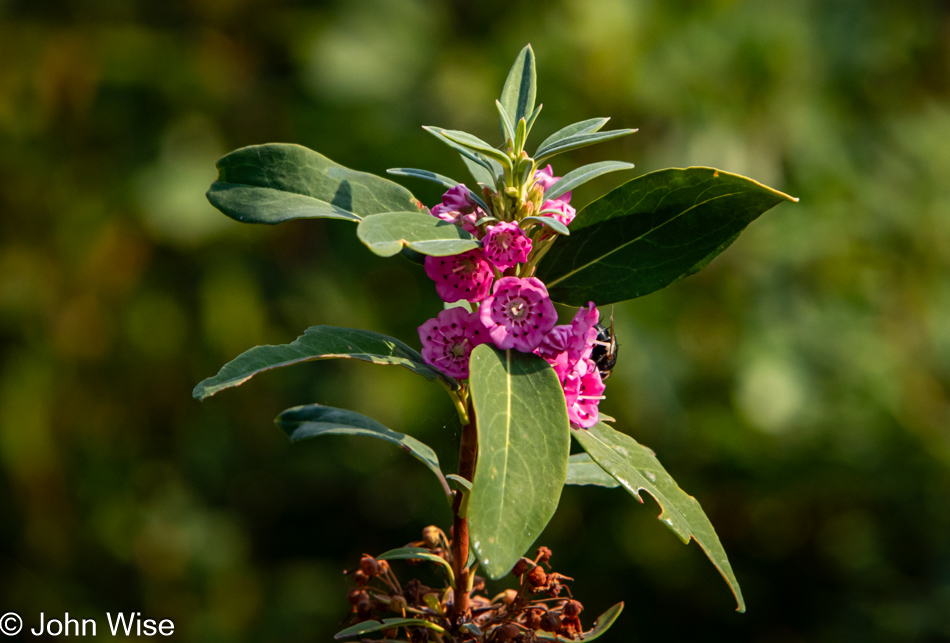
Sometimes, when you find the name of a plant, you want to share it for no other reason than that it’s an interesting one. This is royal dwarf sheep laurel.
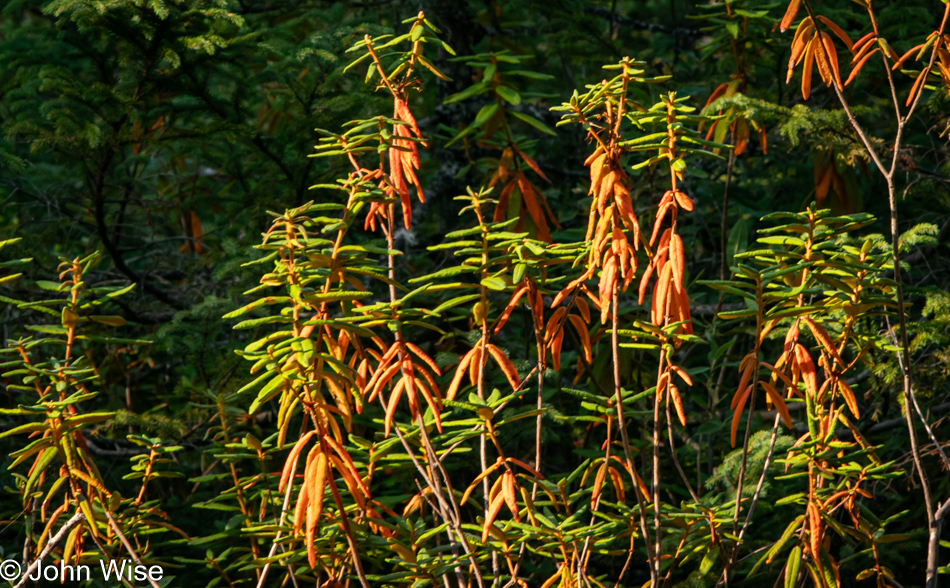
Being in a national park, we knew better than to harvest anything, but upon getting home, I threw some Labrador tea into a shopping cart so we could try the drink popular with Athabaskans and the Inuit.
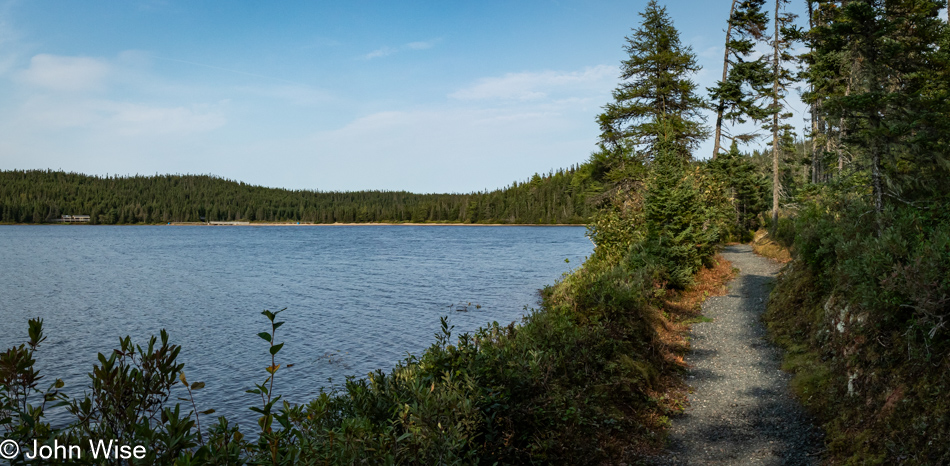
Circling around the eastern shore of Sandy Pond, we are reaching the end of the trail and are beginning to look forward to a break from our race to see as much of Terra Nova as we have.

Maybe the name Sandy Pond should have made it obvious, and then after we arrived, the signs pointing to the swimming area could have been another clue, but a sandy beach was not in my book of expectations.
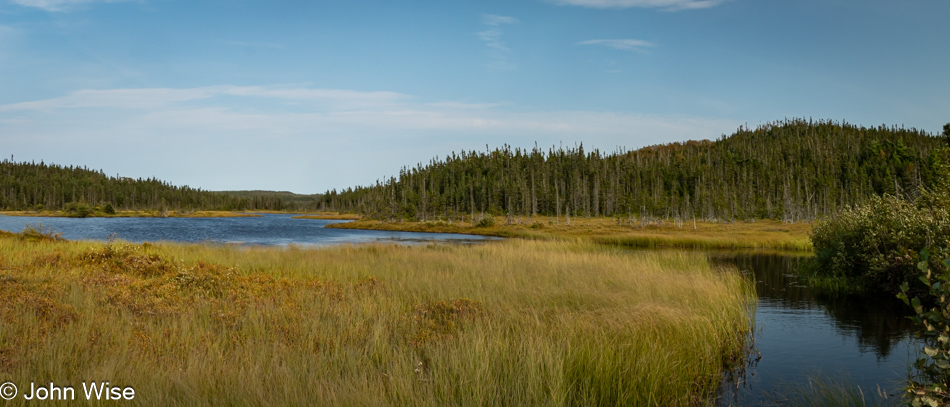
We had one more raised boardwalk to traverse before returning to the parking lot, and again, outside of my expectations, there was this series of ponds to the east of Sandy Pond. I shot 480 photos on this day, and while sitting in a coffee shop writing this post a couple of weeks later, I cannot remember the circumstances surrounding this waterway, but I had an inkling of a memory that told me to check those photos I’m not including from that day. Sure enough, just before this series of four images stitched together in a panorama, there was a close-up shot of the entangled mess of branches that formed one small part of the beaver dams sequestering the waters we are walking above.
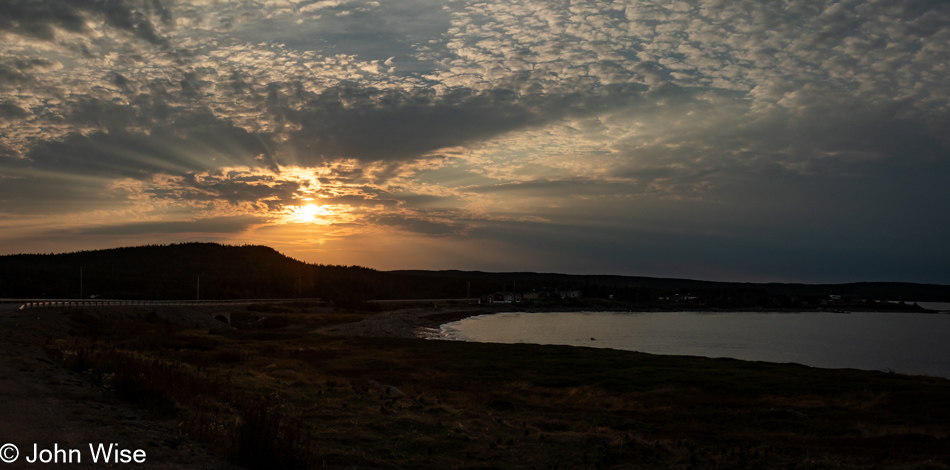
Sometimes, our ability to execute our movements in coordination, allowing for the most accurate chasing of remaining light, hits the mark. Our stop at an Esso Station in Lethbridge also hit that mark, where I spotted a sign for the Dairy Bar that claimed to have dozens of soft serve flavors. Caroline tried insisting that we needn’t stop, but I prevailed, and lucky for her, I did. She left with a maple and blueberry mix of soft serve, and happiness doesn’t begin to describe her joy. We made one error, though: we paid before ever looking at their selection of hard ice cream, and they had Grape-nut ice cream. In addition to the maple soft serve her friend Christine had recommended, Caroline had also read about tiger tail and Grape-nuts ice creams on one of her favorite Internet sources, Atlas Obscura, and here it was. I ordered a scoop so we could try it, knowing that we’d probably throw most of it away, considering how much soft serve she had in the cup she was already eating. To my astonishment and her regret, she finished both.

From the randomly painted trash bins in front yards to boulders and mailboxes, Newfoundlanders enjoy adding a splash of color to their environment.

We were on a detour, not a big one, but one that was taking us up the west side of the peninsula where, in Hodderville, we encountered foxes that appeared far too familiar with passing humans, as in they were looking for handouts. This was our first time seeing black foxes, and while I got a photo of them, it was on the street, and this pretty red fox in the grass looked sweeter.

What a lovely room we checked into at the Russelltown Inn in Bonavista, but if we were going to have a hot dinner, we needed to get moving right back out of our luxury accommodations. A quick scan of options showed me that the Boreal Diner was our best bet, but they recommended reservations. I called, but they couldn’t seat us for another hour. But we could sit at the small 4-person bar immediately, and with that, we locked our room and walked over. Going over the menu, it only took a moment to decide on the 5-course tasting menu until we waffled, considered a 3-course variation, and finally settled on sharing the 5-course while adding an extra scallop appetizer and a tasting size portion of the maitake, carrot polenta, and mint sauce entree.
The restaurant is in a small two-story house and is an absolute gem, surprising us that something so grand should be in such a small town of 3,200 people. The scallop appetizer was the only dish that was wanting; it needed something, but it wasn’t there. No matter, the local bluefin tuna appetizer was amazing, especially the emulsion made from bluefin tuna bits and bobs. The duck preparations, one with a fennel puree and the other with a parsnip puree, were both perfect. The maitake dish hit its mark, and finally, our final entree was the seared ribeye cured in koji served with pickled mushroom puree, celery root, and pickled shallot. Remember all that ice cream and soft serve? That didn’t stop us from ordering dessert, one of which came with us; yes, we ordered two because we couldn’t settle on one. The blueberry cake was packed up, and the strawberry cake with local strawberries and a scoop of partridgeberry sorbet was packed in. It seems futile to point out that this was one more epic day in a sequence of epic days.

